SPACE NEWS
Biden Wants New Rules Over Commercial Spaceflights
Justin Sink
Wed, November 15, 2023

(Bloomberg) -- The Biden administration will ask lawmakers Wednesday to adopt a new framework for regulations governing private spaceflight, as the US grapples with a boom in companies like Jeff Bezos’s Blue Origin LLC, Richard Branson’s Virgin Galactic Holdings Inc. and Elon Musk’s SpaceX offering to bring humans into the cosmos.
The legislative proposal would extend the Department of Transportation’s regulatory authority of spaceflight beyond launch and reentry, giving officials powers to create rules designed to ensure the safety of humans when in orbit, on a commercial space station, or while visiting the moon.
The Transportation Department would also get new authority to license in-space transportation of goods, including fuel, from space to the lunar surface. The proposal would also give the Commerce Department additional authority over activities in space like assembly or manufacturing missions, or launching satellites to clear space debris.
The proposed rules would “provide a safe, predictable environment for commercial space activities,” NASA Administrator Bill Nelson said in a statement.
Vice President Kamala Harris, who leads the administration’s National Space Council, directed the drafting of a regulatory plan last year as novel commercial space activity continued to grow.
Justin Sink
Wed, November 15, 2023

(Bloomberg) -- The Biden administration will ask lawmakers Wednesday to adopt a new framework for regulations governing private spaceflight, as the US grapples with a boom in companies like Jeff Bezos’s Blue Origin LLC, Richard Branson’s Virgin Galactic Holdings Inc. and Elon Musk’s SpaceX offering to bring humans into the cosmos.
The legislative proposal would extend the Department of Transportation’s regulatory authority of spaceflight beyond launch and reentry, giving officials powers to create rules designed to ensure the safety of humans when in orbit, on a commercial space station, or while visiting the moon.
The Transportation Department would also get new authority to license in-space transportation of goods, including fuel, from space to the lunar surface. The proposal would also give the Commerce Department additional authority over activities in space like assembly or manufacturing missions, or launching satellites to clear space debris.
The proposed rules would “provide a safe, predictable environment for commercial space activities,” NASA Administrator Bill Nelson said in a statement.
Vice President Kamala Harris, who leads the administration’s National Space Council, directed the drafting of a regulatory plan last year as novel commercial space activity continued to grow.
Nasa’s James Webb telescope spots collection of shocking materials on distant planet
Andrew Griffin
Wed, November 15, 2023
(The Independent)
Nasa’s James Webb Space Telescope has spotted a “fluffy” planet with an atmosphere made up of a collection of intriguing materials.
The planet has a similar water and cloud cycle to that of our own Earth. But the clouds are made of sand and the clouds are made of silicate.
Other parts of the atmosphere are more like our own and could be an intriguing hint of the telescope’s ability to investigate planets that might be home to distant alien life.
Data gathered using the telescope revealed that WASP-107b - a planet 200 lightyears away that orbits a star in the constellation of Virgo - has a dynamic atmosphere made up of water vapour, sulphur dioxide, and sand clouds.
Scientists say this exoplanet - a planet outside the Solar System - has a cloud cycle similar to Earth, except the droplets are made of sand instead of water vapour.
While clouds have been inferred on other exoplanets, the researchers said their work, published in the journal Nature, is the first instance where astronomers have been able to identify the chemical composition of clouds in a distant planet.
Study author Dr Achrene Dyrek, an astronomer at CEA - a French government-funded research organisation in Paris, said: “JWST enables a deep atmospheric characterisation of an exoplanet that does not have any counterpart in our Solar System, we are unravelling new worlds!”
European astronomers used JWST’s Mid-Infrared Instrument (MIRI) to peer deep into WASP-107b’s atmosphere.
WASP-107b is just a little smaller than Jupiter but its mass is less than 10% of the gas giant.
This makes it one of the lowest density exoplanets known, thus earning the label “fluffy” - like candyfloss.
The fluffiness of this exoplanet allowed astronomers to look much deeper into the atmosphere - roughly 50 times deeper compared to Jupiter - revealing its complex chemical composition.
While the team found the presence of water vapour, SO2, and silicate clouds, they said the greenhouse gas methane (CH4) was notably absent, hinting at “a potentially warm interior”.
Just like clouds on Earth, the sand clouds high in WASP-107b’s atmosphere undergo a continuous cycle of sublimation and condensation.
Study author Dr Michiel Min, a senior scientist at the SRON Netherlands Institute for Space Research, said: “The fact that we see these sand clouds high up in the atmosphere must mean that the sand rain droplets evaporate in deeper, very hot layers and the resulting silicate vapour is efficiently moved back up, where they recondense to form silicate clouds once more.
“This is very similar to the water vapour and cloud cycle on our own Earth but with droplets made of sand.”
The researchers said their work marks “a significant milestone” in understanding more about the climatic conditions of other exotic worlds.
Study author Professor Leen Decin, of KU Leuven in Belgium, said: “The discovery of clouds of sand, water, and sulphur dioxide on this fluffy exoplanet by JWST’s MIRI instrument is a pivotal milestone.
“It reshapes our understanding of planetary formation and evolution, shedding new light on our own Solar System.”
Hubble Telescope revisits gorgeous spiral galaxy, offering a newly filtered view (photo)
Samantha Mathewson
Wed, November 15, 2023

Hubble space telescope view of a spiral galaxy in deep space, showing bright pink patches along its spiral arms.
The Hubble Space Telescope has captured a striking new view of a distant spiral galaxy whose star-studded arms are all tangled up.
Located about 30 million light-years from Earth, NGC 1385 is a barred spiral galaxy with several arms that are mixed together, creating an oval appearance. The galaxy's core glows brightly with an active, growing black hole that feeds on neighboring, densely packed star clusters.
This is not the first time NGC 1385 has been the focus of the famous space telescope. Hubble photographed the galaxy a few years back, using different filters. The more recent photo, which the European Space Agency (ESA) shared on Nov. 13, captures more pinkish-red and umber shades, whereas the former image, shared on Aug. 16, 2021, was dominated by cool blues. Both images show dark filaments of dust woven through the galaxy.
Related: The best Hubble Space Telescope images of all time!
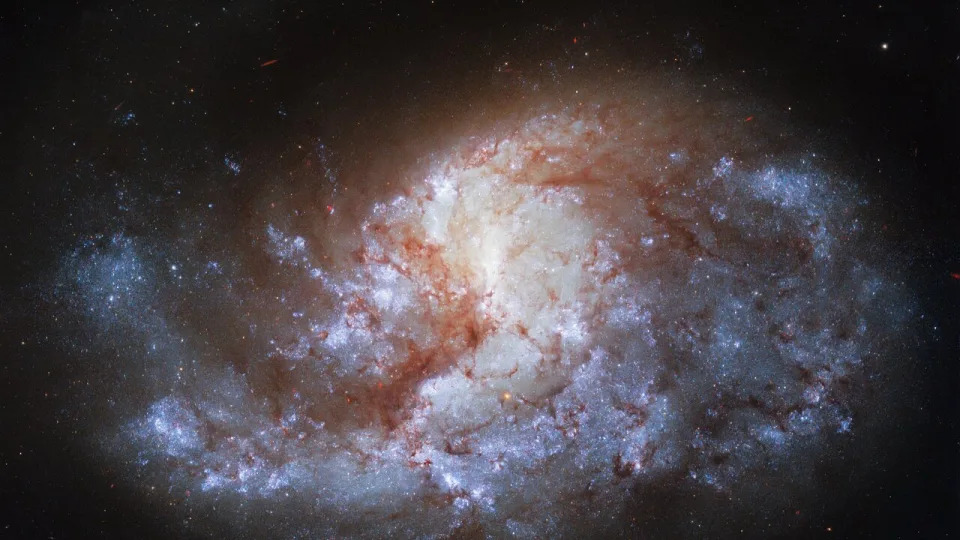
hubble space telescope view of a spiral galaxy in deep space, showing cool blue stars near its core.
"It is understandable to be a bit confused as to how the same galaxy, imaged twice by the same telescope, could be represented so differently in two different images," ESA officials said in a Nov. 13 statement. "The reason is that — like all powerful telescopes used by professional astronomers for scientific research — Hubble is equipped with a range of filters."
Hubble uses both infrared and ultraviolet filters. Infrared light is represented in red, while blue areas correspond to ultraviolet light. Using images taken with different filters, the Hubble team is able to discern how to properly color an image and reveal finite details that may otherwise be unnoticeable.
"These highly specialized components have little similarity to filters used on social media: those software-powered filters are added after the image has been taken, and cause information to be lost from the image as certain colors are exaggerated or reduced for aesthetic effect," ESA officials said. "In contrast, telescope filters are pieces of physical hardware that only allow very specific wavelengths of light to enter the telescope as the data are being collected."
Using extra filters, the recent Hubble view captures more detailed features of NGC 1385, including its distinct central bar-shaped structure and the swirling path of its tangled spiral arms. The differences observed in the two images highlight the importance of Hubble's versatile filters.
"Astronomers can probe extremely specific parts of the electromagnetic spectrum," ESA officials said. "This is very useful for a number of reasons; for example, physical processes within certain elements emit light at very specific wavelengths, and filters can be optimized to these wavelengths."
Located in the constellation Fornax — which is Latin for "furnace" — NGC 1385 has been aptly nicknamed the Heart of the Furnace, as bright pink patches and filaments of dark red dust stem across the galaxy's glowing core like arteries of the heart.
Samantha Mathewson
Wed, November 15, 2023

Hubble space telescope view of a spiral galaxy in deep space, showing bright pink patches along its spiral arms.
The Hubble Space Telescope has captured a striking new view of a distant spiral galaxy whose star-studded arms are all tangled up.
Located about 30 million light-years from Earth, NGC 1385 is a barred spiral galaxy with several arms that are mixed together, creating an oval appearance. The galaxy's core glows brightly with an active, growing black hole that feeds on neighboring, densely packed star clusters.
This is not the first time NGC 1385 has been the focus of the famous space telescope. Hubble photographed the galaxy a few years back, using different filters. The more recent photo, which the European Space Agency (ESA) shared on Nov. 13, captures more pinkish-red and umber shades, whereas the former image, shared on Aug. 16, 2021, was dominated by cool blues. Both images show dark filaments of dust woven through the galaxy.
Related: The best Hubble Space Telescope images of all time!

hubble space telescope view of a spiral galaxy in deep space, showing cool blue stars near its core.
"It is understandable to be a bit confused as to how the same galaxy, imaged twice by the same telescope, could be represented so differently in two different images," ESA officials said in a Nov. 13 statement. "The reason is that — like all powerful telescopes used by professional astronomers for scientific research — Hubble is equipped with a range of filters."
Hubble uses both infrared and ultraviolet filters. Infrared light is represented in red, while blue areas correspond to ultraviolet light. Using images taken with different filters, the Hubble team is able to discern how to properly color an image and reveal finite details that may otherwise be unnoticeable.
"These highly specialized components have little similarity to filters used on social media: those software-powered filters are added after the image has been taken, and cause information to be lost from the image as certain colors are exaggerated or reduced for aesthetic effect," ESA officials said. "In contrast, telescope filters are pieces of physical hardware that only allow very specific wavelengths of light to enter the telescope as the data are being collected."
Using extra filters, the recent Hubble view captures more detailed features of NGC 1385, including its distinct central bar-shaped structure and the swirling path of its tangled spiral arms. The differences observed in the two images highlight the importance of Hubble's versatile filters.
"Astronomers can probe extremely specific parts of the electromagnetic spectrum," ESA officials said. "This is very useful for a number of reasons; for example, physical processes within certain elements emit light at very specific wavelengths, and filters can be optimized to these wavelengths."
Located in the constellation Fornax — which is Latin for "furnace" — NGC 1385 has been aptly nicknamed the Heart of the Furnace, as bright pink patches and filaments of dark red dust stem across the galaxy's glowing core like arteries of the heart.
Ben Turner
Tue, November 14, 2023
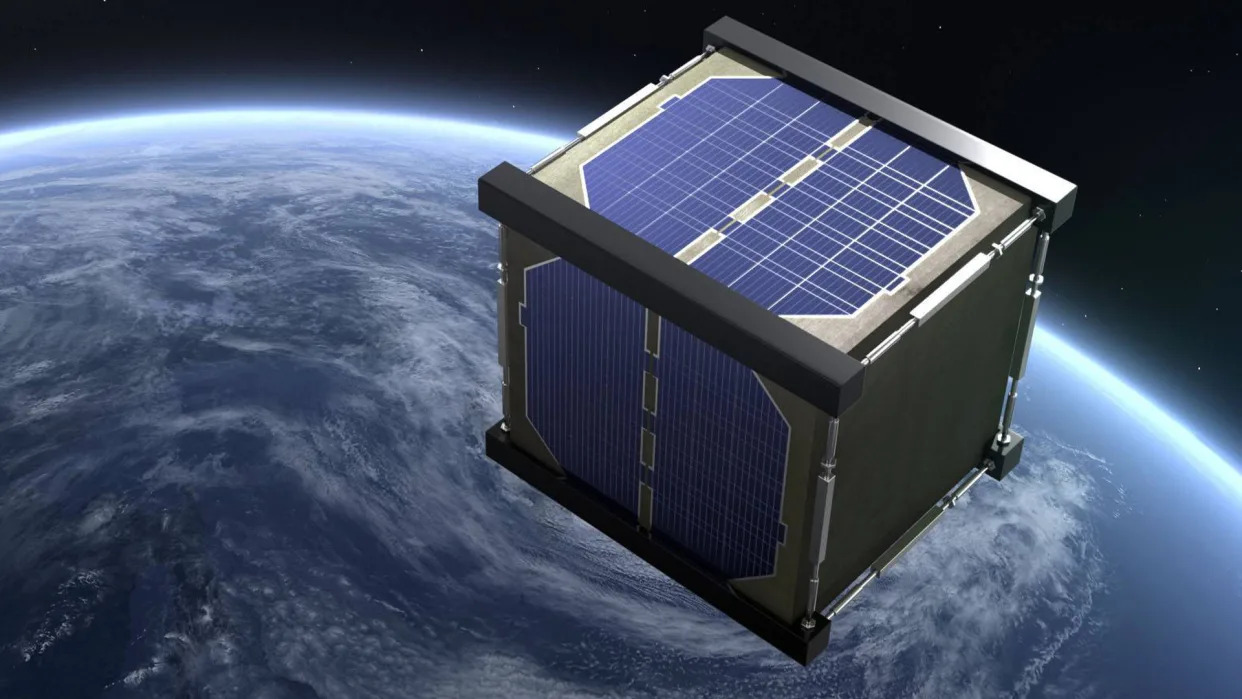
Illustration of a wooden square satellite as it orbits the earth.
NASA and the Japan Aerospace Exploration Agency (JAXA) are planning to launch the world's first wooden satellite into space in a bid to make spaceflight more sustainable.
LignoSat, a coffee mug-size satellite made from magnolia wood, is set to launch into Earth's orbit by summer 2024, according to the space agencies.
Wood doesn't burn or rot in the lifeless vacuum of space, but it will incinerate into a fine ash upon reentry into Earth's atmosphere — making it a surprisingly useful, biodegradable material for future satellites. After successfully testing their wood samples aboard the International Space Station (ISS) earlier this year, the scientists believe the test satellite is fit for launch.
"Three wood specimens were tested and showed no deformation after space exposure," the researchers said in a statement in May. "Despite the extreme environment of outer space involving significant temperature changes and exposure to intense cosmic rays and dangerous solar particles for ten months, tests confirmed no decomposition or deformations, such as cracking, warping, peeling, or surface damage."
To decide which wood to use, the scientists sent three wood samples — magnolia, cherry or birch — to the ISS to be kept in a module that was exposed to space. The researchers settled upon magnolia because it is less likely to split or break during manufacture.
RELATED STORIES
More than 9,300 tons (8,440 metric tons) of space objects — including space junk such as inoperative satellites and chunks of spent rocket stages — currently orbit Earth. But the shiny metals they are made from, such as lightweight titanium and aluminum, increase the overall brightness of the night sky by more than 10% over large parts of the planet, creating ambient light pollution that makes distant space phenomena harder to detect.
Spacecraft made from metal are also expensive and pose a threat to the ISS, other spacecraft carrying humans and — if they're big enough to survive reentry — people on Earth too. Wooden satellites like LignoSat should theoretically be less harmful as space
Dark matter data salvaged from balloon-borne telescope that landed hard on Earth
Sharmila Kuthunur
Tue, November 14, 2023
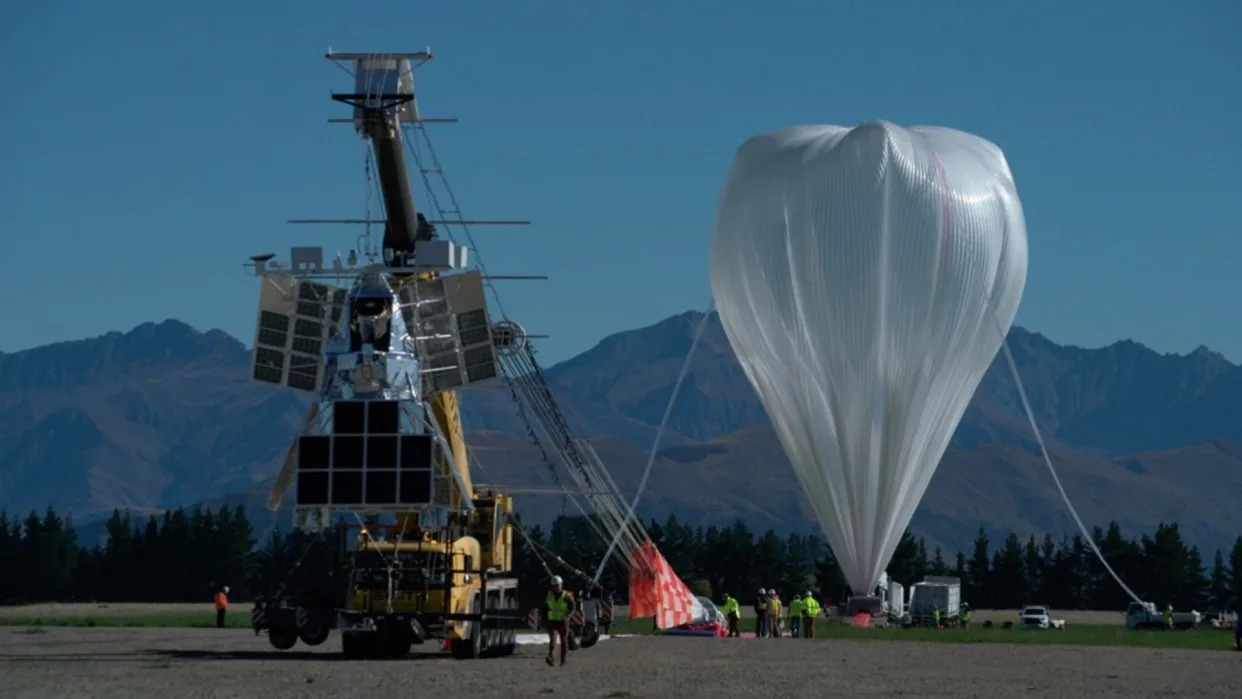
A large white partially inflated balloon rests on the ground, with mountains in the background.
A NASA telescope that launched on a football-stadium-sized balloon earlier this year lost communication with Earth and suffered damage upon landing in Argentina in June.
Luckily, the data it had collected — 200 gigabytes' worth of stunning images of galaxy clusters taken while floating 100,000 feet (30,000 meters) above Earth's surface — had been copied to old-fashioned SD drives and parachuted to the ground safely, showing that valuable science data can be salvaged even in a "worst-case scenario," scientists reported on Tuesday (Nov. 14).
The $10 million balloon-borne observatory, known as the Super Pressure Balloon Imaging Telescope (SuperBIT), was designed to give astronomers pocket-friendly observations of celestial objects. The main goal was to help map dark matter around galaxy clusters, primarily by measuring how the celestial objects warp space and time around them.
Related: Meet SuperBIT, the next-generation telescope that rides above the clouds on a balloon
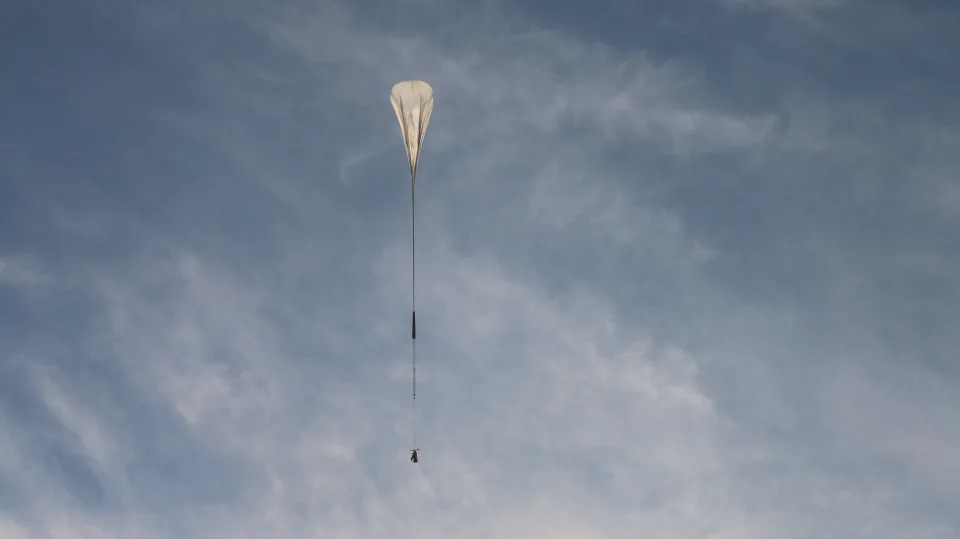
a large white balloon carries a dark, cylindrical payload through a blue sky.
After lifting off in April from Wānaka Airport in New Zealand, SuperBIT circled Earth about five times to capture images of its galaxy cluster targets in visible to near-ultraviolet light wavelengths. Its targets included the star-forming regions of the Tarantula Nebula 161,000 light-years from Earth, the two colliding Antennae galaxies 60 million light-years away and the Pinwheel spiral galaxy, among others.
SuperBIT's planned 100-day-long mission was shortened to 40 days due to "conflicting wind predictions," at which point the telescope made its way back to the targeted landing spot, a remote hill in Argentina. Upon touchdown, however, the parachute failed to disconnect from its payload after an equipment failure, dragging the telescope over rough terrain for a couple of kilometers while high winds blew overhead.
"Our telescope got to the point where it was completely destroyed, and we lost high-bandwidth communications," Ellen Sirks of the University of Sydney, lead author of the new SuperBIT study, said in a statement.
Usually, data gathered by balloon-borne telescopes like SuperBIT is downloaded using a satellite, but quick downloads require line-of-sight communications, something that is not always feasible.
"In our case, we were getting so much data per night that it would just be incredibly slow and expensive to retrieve this data mid-flight," Sirks said. "At the moment, the most efficient way for us to download data is to copy it onto an SD drive and just drop it to Earth, which is kind of crazy, but it works well."
So she and her colleagues from Australia, the U.K., the U.S., Canada, Europe and Taiwan developed "recovery packages" consisting of tiny computers with SD cards that store data, a homemade satellite link for communication with the telescope and parachutes sheathed in waterproof chicken roasting bags.

close-up view of a motherboard and other electronics on a small green platform shaped like a skateboard deck.
RELATED STORIES:
— This 'tarantula' in space could teach us the secrets of dark matter
— How much of the universe is dark matter?
— Balloon-borne telescope lifts off to study black holes and neutron stars
Retrieving SuperBIT's recovery package from the Argentinian countryside was a mission in itself and included help from the local police, scientists involved with the mission say.
"We couldn't find one at first, and when we did, there were cougar tracks in the snow near it, so we thought maybe the chicken roast bag was not the best idea," said Sirks. "It was quite funny. But we did retrieve them quite easily."
Although Sirks and her team have been developing this system for about five years, the recent mission marked the first time they tested it in its final configuration. Not only did it work, Sirks said, "it was really quite essential to the mission's success."
"It's got to the point where NASA wants to start producing these packages for other science missions as well, so this was really our final test to show that this system works."
This research is described in a paper published on Tuesday in the journal Aerospace.
Sharmila Kuthunur
Tue, November 14, 2023

A large white partially inflated balloon rests on the ground, with mountains in the background.
A NASA telescope that launched on a football-stadium-sized balloon earlier this year lost communication with Earth and suffered damage upon landing in Argentina in June.
Luckily, the data it had collected — 200 gigabytes' worth of stunning images of galaxy clusters taken while floating 100,000 feet (30,000 meters) above Earth's surface — had been copied to old-fashioned SD drives and parachuted to the ground safely, showing that valuable science data can be salvaged even in a "worst-case scenario," scientists reported on Tuesday (Nov. 14).
The $10 million balloon-borne observatory, known as the Super Pressure Balloon Imaging Telescope (SuperBIT), was designed to give astronomers pocket-friendly observations of celestial objects. The main goal was to help map dark matter around galaxy clusters, primarily by measuring how the celestial objects warp space and time around them.
Related: Meet SuperBIT, the next-generation telescope that rides above the clouds on a balloon

a large white balloon carries a dark, cylindrical payload through a blue sky.
After lifting off in April from Wānaka Airport in New Zealand, SuperBIT circled Earth about five times to capture images of its galaxy cluster targets in visible to near-ultraviolet light wavelengths. Its targets included the star-forming regions of the Tarantula Nebula 161,000 light-years from Earth, the two colliding Antennae galaxies 60 million light-years away and the Pinwheel spiral galaxy, among others.
SuperBIT's planned 100-day-long mission was shortened to 40 days due to "conflicting wind predictions," at which point the telescope made its way back to the targeted landing spot, a remote hill in Argentina. Upon touchdown, however, the parachute failed to disconnect from its payload after an equipment failure, dragging the telescope over rough terrain for a couple of kilometers while high winds blew overhead.
"Our telescope got to the point where it was completely destroyed, and we lost high-bandwidth communications," Ellen Sirks of the University of Sydney, lead author of the new SuperBIT study, said in a statement.
Usually, data gathered by balloon-borne telescopes like SuperBIT is downloaded using a satellite, but quick downloads require line-of-sight communications, something that is not always feasible.
"In our case, we were getting so much data per night that it would just be incredibly slow and expensive to retrieve this data mid-flight," Sirks said. "At the moment, the most efficient way for us to download data is to copy it onto an SD drive and just drop it to Earth, which is kind of crazy, but it works well."
So she and her colleagues from Australia, the U.K., the U.S., Canada, Europe and Taiwan developed "recovery packages" consisting of tiny computers with SD cards that store data, a homemade satellite link for communication with the telescope and parachutes sheathed in waterproof chicken roasting bags.

close-up view of a motherboard and other electronics on a small green platform shaped like a skateboard deck.
RELATED STORIES:
— This 'tarantula' in space could teach us the secrets of dark matter
— How much of the universe is dark matter?
— Balloon-borne telescope lifts off to study black holes and neutron stars
Retrieving SuperBIT's recovery package from the Argentinian countryside was a mission in itself and included help from the local police, scientists involved with the mission say.
"We couldn't find one at first, and when we did, there were cougar tracks in the snow near it, so we thought maybe the chicken roast bag was not the best idea," said Sirks. "It was quite funny. But we did retrieve them quite easily."
Although Sirks and her team have been developing this system for about five years, the recent mission marked the first time they tested it in its final configuration. Not only did it work, Sirks said, "it was really quite essential to the mission's success."
"It's got to the point where NASA wants to start producing these packages for other science missions as well, so this was really our final test to show that this system works."
This research is described in a paper published on Tuesday in the journal Aerospace.
Comets that 'bounce' from planet to planet could spread life across the universe
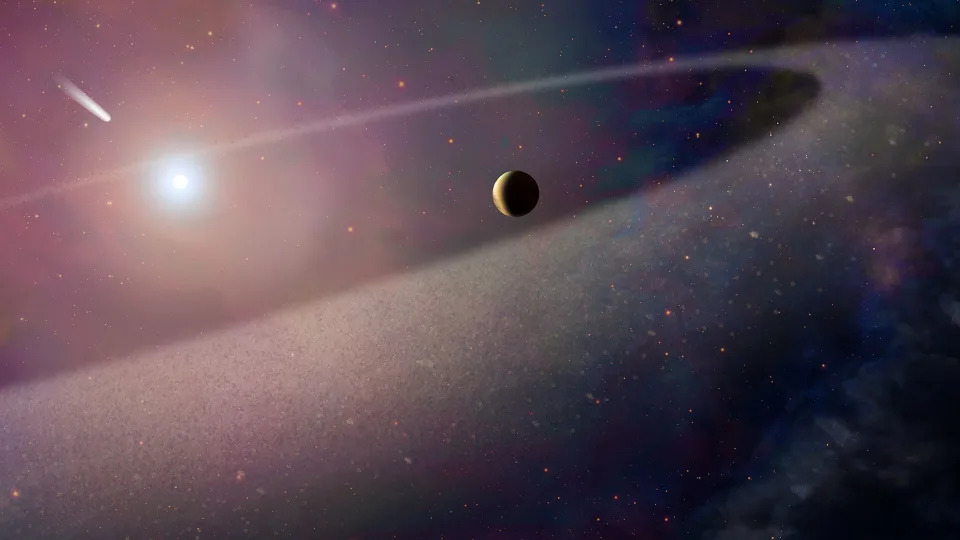
A belt of comet-like bodies orbiting the white dwarf, similar to our solar system’s Kuiper Belt.
In recent decades, astronomers have proved that some comets and asteroids contain prebiotic molecules, including amino acids, hydrogen cyanide and vitamins, such as vitamin B3. While none of these organic compounds constitutes life in its own right, they are all necessary for life as we know it.
The researchers found that comets could, indeed, deliver intact prebiotic molecules directly to planets — but only under certain circumstances. First, the comet has to be traveling relatively slowly — at or below 9 miles per second (15 kilometers per second). Otherwise, the heat it would encounter while entering a planet's atmosphere would burn up the delicate organic molecules instantly. (For comparison, NASA estimates that Halley's Comet was moving at roughly 34 miles per second, or 55 km per second, during its last close approach to the sun, in 1986.)
The team calculated that the best place for comets to hit the cosmic brakes would be in "peas in a pod" systems, where a cluster of planets orbit in close proximity. This would cause an incoming comet to bounce from one planet's orbit to the next like a pinball. As it traveled, it would decelerate, until it eventually entered one planet's atmosphere slowly enough to deposit its prebiotic cargo. Crucially, the team also found that planets orbiting smaller stars or planets in less densely packed systems would be less likely to receive successful comet deliveries.
While this might not be the only avenue for life to arise in the galaxy, the researchers say their simulations could help give scientists a better idea of where to look for extraterrestrial life. And with more than 5,000 exoplanets discovered so far, narrowing down this search will become increasingly important.
"It's exciting that we can start identifying the type of systems we can use to test different origin scenarios," Anslow said. "It's an exciting time, being able to combine advances in astronomy and chemistry to study some of the most fundamental questions of all."
'Devil Comet' hurtling toward Earth is set to shine extra bright in North State skies
Jessica Skropanic, Redding Record Searchlight
Tue, November 14, 2023
A massive comet twice the size of Mt. Everest will hurtle past Earth in spring 2024.
The Devil Comet is making its first return since 1954, astronomers said.
And this comet has an ice volcano.
After a series of explosions that happened as recently as October, scientists now predict the comet will shine extra bright in North State skies.
How close will Devil Comet get to Earth?
Nicknamed for its two spiky “horns,” Devil Comet could be visible to the naked eye by April 21.
Astronomers predict it will be at its brightest on June 2, when it’s at its closest to Earth — but still 144 million miles away.
That’s about the distance between the sun and Mars, so we don’t have worry about this comet threatening Earth, according to astronomers: We can just sit back and watch what will hopefully be a stellar celestial show.
After that, Devil Comet won’t return for 71 years.
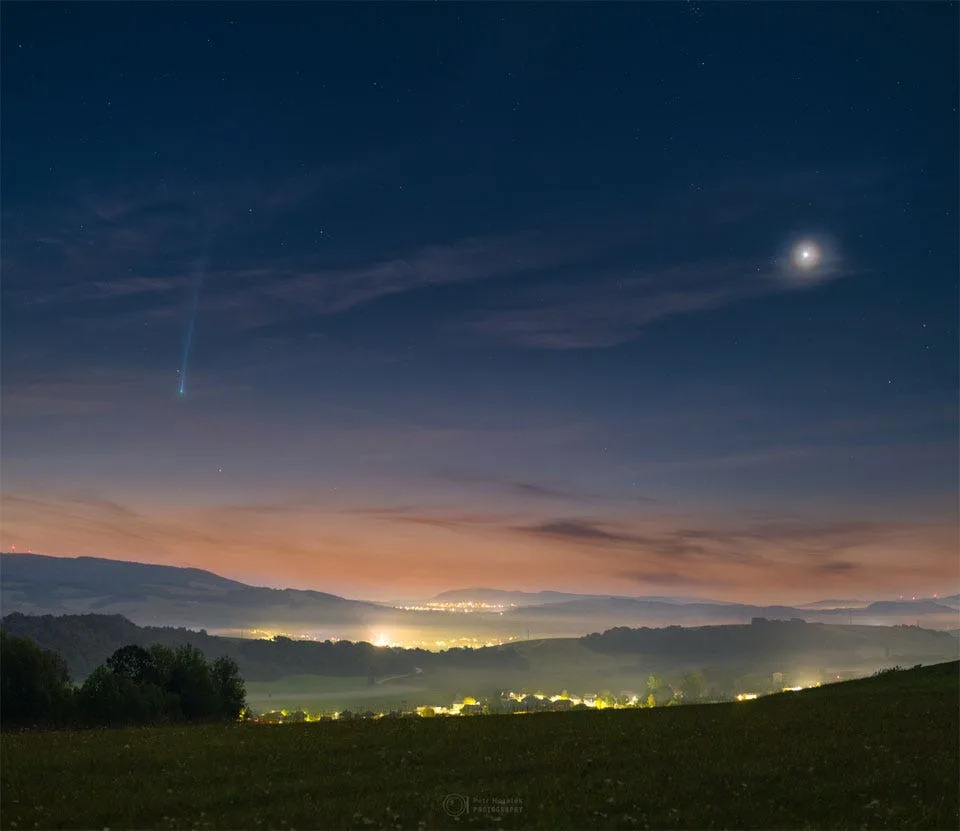
Photo of Comet Nishimura in September 2023.
Note to readers: If you appreciate the work we do here at the Redding Record Searchlight, please consider subscribing yourself or giving the gift of a subscription to someone you know.
Devil Comet has hot tails, cold volcano
One of the earliest known records of Devil Comet came from the Chinese more than 700 years ago. The comet got its official name, 12/P Pons-Brooks, after French astronomer Jean-Louis Pons and English astronomer William Robert Brooks spotted it in the 1800s, according to EarthSky.org.
Devil Comet belongs to an elite group of known cryovolcanic comets, meaning it has an ice volcano. Instead of molten rock, cryovolcanoes erupt water and ice, ammonia, methane and/or carbon dioxide. Those materials quickly freeze into distinctive shapes on the comet’s surface, according to NASA and Earth.com.
Sun-orbiting comets, like the Devil Comet and Halley’s Comet, are made of dust and ice. As they get close to the sun, the heat makes the comets and their long, streaking “tails” of gas and dust glow. Comet tails can stretch for millions of miles, according to NASA.
Since June 2022, astronomers reported violent eruptions on Devil Comet, some as recent as October. That means solar radiation is heating up the comet's core, making Devil Comet spew ice and gas clouds that formed its horn shapes, according to the British Astronomical Association.
“The outburst gave the comet a peculiar ‘horned’ appearance” resembling “the Millennium Falcon of ‘Star Wars.’ Woo hoo!,” Earthsky.org astronomy journalist Kelly Kizer Whitt wrote.
Why Devil Comet will fly past Earth, over North State, in 2024
Comets like Devil Comet “are leftovers from the formation of the solar system 4.6 billion years ago,” according to NASA.
Gravity from the sun or a planet can pull comets out of where they usually exist — in the Kuiper Belt beyond Neptune, or in the Oort Cloud. The latter is a sphere of loose particles of ice and dust at the outer edge of the solar system, NASA said.
Try to imagine a snow globe 50 times larger than the solar system.
The sun's gravitational pull can make a comet change course, sending it into a long oval orbit around the sun. “When the comet is in the inner solar system, either coming or going, that's when we may see it in our skies,” NASA said.
However, comet behavior is hard for scientists to predict since comets have wide orbits and sometimes move erratically. So how bright Devil Comet will be is a game of wait-and-see.
Best chances to see 12/P Pons-Brooks, AKA the Devil Comet
Best places to watch include rural areas away from city lights. Check ahead for safe stopping places including spots near Hat Creek, Burney, Shingletown, Mount Shasta and Dunsmuir, Yreka and near national parks and forests.
Keep in mind most parks close at dusk during their late spring and summer season.
For more information on comets go to NASA's SpacePlace at spaceplace.nasa.gov/comets/en.
Meteor showers to watch in November and December
You don't have to wait until 2024 to view something spectacular in North State skies.
Here are four meteor showers peaking as early as Thursday, Nov. 16.
Leonids Meteor Shower: Look to the southern sky to see the Leonids, peaking from Nov. 16 to 18. Best times to watch are between midnight and dawn. This meteor shower varies, with a few fizzling fireballs per hour some years, then pounding the atmosphere with hundreds other years. This year will likely be a lighter shower. Average meteors per hour: 10
Andromedid Meteor Shower: This little shower peaks in the late evening on Nov. 25 to 27. It's point of origin is the southern sky. Average meteors per hour: Five
Geminids Meteor Shower: Watch at any time of night to see this shower, peaking on Dec. 13 and 14. It originates from the northeastern sky. Average meteors per hour: 75
Ursids Meteor Shower: This brief little shower — originating from the northern sky — is from debris left by comet 108P/Tuttle. It peaks on Dec. 21 and 22. Best times to watch are from midnight to dawn. Average meteors per hour: Five
More: Newly-discovered comet, an eclipse, meteor showers and other sky wonders are on the way
Jessica Skropanic is a features reporter for the Record Searchlight/USA Today Network. She covers science, arts, social issues and news stories. Follow her on Twitter @RS_JSkropanic and on Facebook. Join Jessica in the Get Out! Nor Cal recreation Facebook group. To support and sustain this work, please subscribe today. Thank you.
This article originally appeared on Redding Record Searchlight: Star Wars spaceship-shaped comet to shine bright over Redding in 2024
How Long Does It Take to Get to the Moon?
Valerie Stimac, Austin Henderson
Wed, November 15, 2023
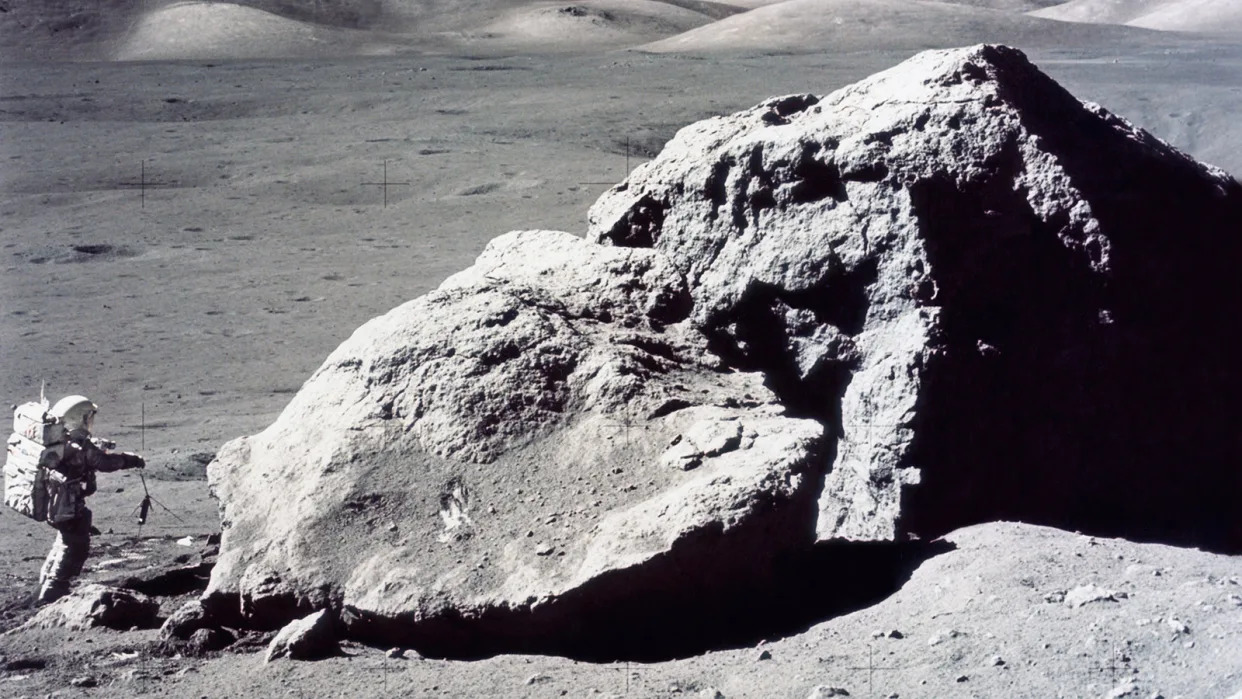
American geologist and astronaut Harrison Hagan Schmitt takes rock samples from the surface of the moon during America's last moon landing mission of the 20th century, Apollo 17, December 1972. Space Frontiers/Getty Images
Boldly glowing in the night sky, the moon has long been an object of fascination. It's not just a pretty face in our solar system; it's a natural satellite that affects the tides, animal sleep cycles (including humans!) and hormones.
But how long does it take to get to the moon? Humans have long been inspired to look up and reach beyond the atmosphere of our own planet — that's part of why President John F. Kennedy set his sights on NASA's mission objective to travel to the moon in the 1960s — so it's only natural to wonder how long the journey takes.
So far, American astronauts have made nine journeys to the moon — six of which landed on the lunar surface. NASA, other governments, and other private companies are now planning crewed missions back to the moon, which will give us even more data about how long it takes to make the trip.
Megan I. Gannon
Tue, November 14, 2023
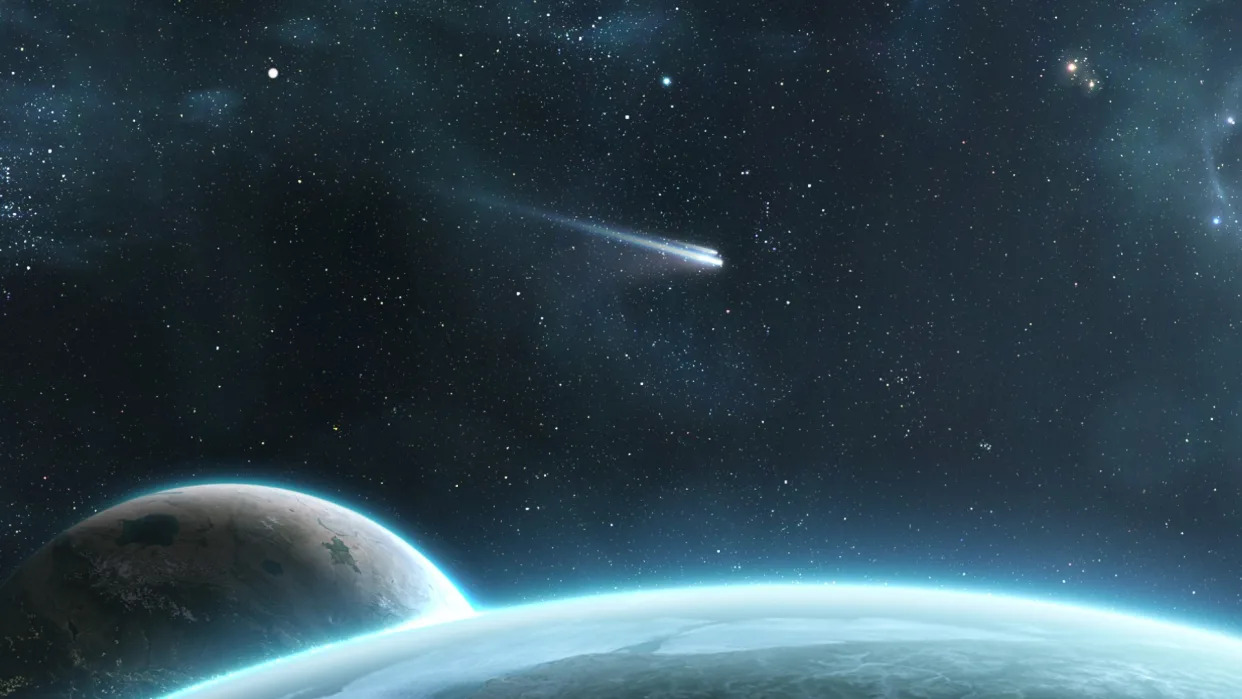
A comet flies through space above a large planet.
Scientists suspect that comets may have delivered the organic ingredients necessary to cook up life on Earth, and new research shows how exoplanets could have received these special deliveries from comets, too.
In its early history, Earth was bombarded with impacts from asteroids, comets and other cosmic bodies leftover from the formation of the solar system. Scientists still debate how the planet got its water and the molecules needed to form life, but comets are likely candidates.
But if comets could have potentially delivered the seeds of life to Earth, could they do the same for exoplanets elsewhere in the universe? With that question in mind, a team of researchers from University of Cambridge's Institute of Astronomy developed mathematical models that helped them show how comets could theoretically deliver similar building blocks of life to other planets in the Milky Way galaxy.
While the research is far from conclusive evidence for life on other worlds, the team's findings could help narrow down the search for life-hosting exoplanets.
"We're learning more about the atmospheres of exoplanets all the time, so we wanted to see if there are planets where complex molecules could also be delivered by comets," study author Richard Anslow from the University of Cambridge's Institute of Astronomy said in a statement. "It's possible that the molecules that led to life on Earth came from comets, so the same could be true for planets elsewhere in the galaxy."
Related: Comet 67P has the building blocks of life — smells like mothballs and almonds
In the last few decades, scientists have been learning more about the so-called "prebiotic molecules" found within comets that could have led to life. For example, in 2009, samples retrieved from Comet Wild 2 during NASA's Stardust mission were found to contain glycine, an amino acid and a building block of protein. The European Space Agency's Rosetta mission also detected organic molecules in the atmosphere of Comet 67P/Churyumov-Gerasimenko between 2014 and 2016.
But these organic molecules might get destroyed during a high-speed, high-temperature impact with a planet. That means Anslow and his colleagues had to find scenarios where a comet crash in another solar system would be slow enough for these the ingredients for life to survive intact.
For solar systems with stars similar to the sun, the lowest velocity impacts would be most likely in where multiple planets are tightly packed together, the researchers found through their simulations. Scientists have dubbed these types of planetary systems "peas-in-a-pod systems." A comet traveling from the outer reaches of such a system would get slowed down as it bounces between the orbits of these planets.
RELATED STORIES:
— See every comet photo (and more) from Europe's Rosetta probe
— Comet Impacts May Have Jump-Started Life on Earth
— Life May Be Common in the Milky Way, Thanks to Comet Swapping
Meanwhile, the team's simulations suggest there might be "unique challenges for life" on rocky planets surrounding red dwarf stars, officially known as M-dwarf stars. These are the most common stars in the galaxy and they have been a popular target for exoplanet-hunting astronomers.
But rocky planets in such a system also see more high-velocity impacts. A comet's chance at seeding life there could be doomed, especially if the planets are more widely spaced.
"It's exciting that we can start identifying the type of systems we can use to test different origin scenarios," Anslow said in a statement. "It's a different way to look at the great work that's already been done on Earth. What molecular pathways led to the enormous variety of life we see around us? Are there other planets where the same pathways exist? It's an exciting time, being able to combine advances in astronomy and chemistry to study some of the most fundamental questions of all."
This research was published today in the journal Proceedings of the Royal Society A.
'Bouncing' comets may be delivering the seeds of life to alien planets, new study finds
Joanna Thompson
Tue, November 14, 2023
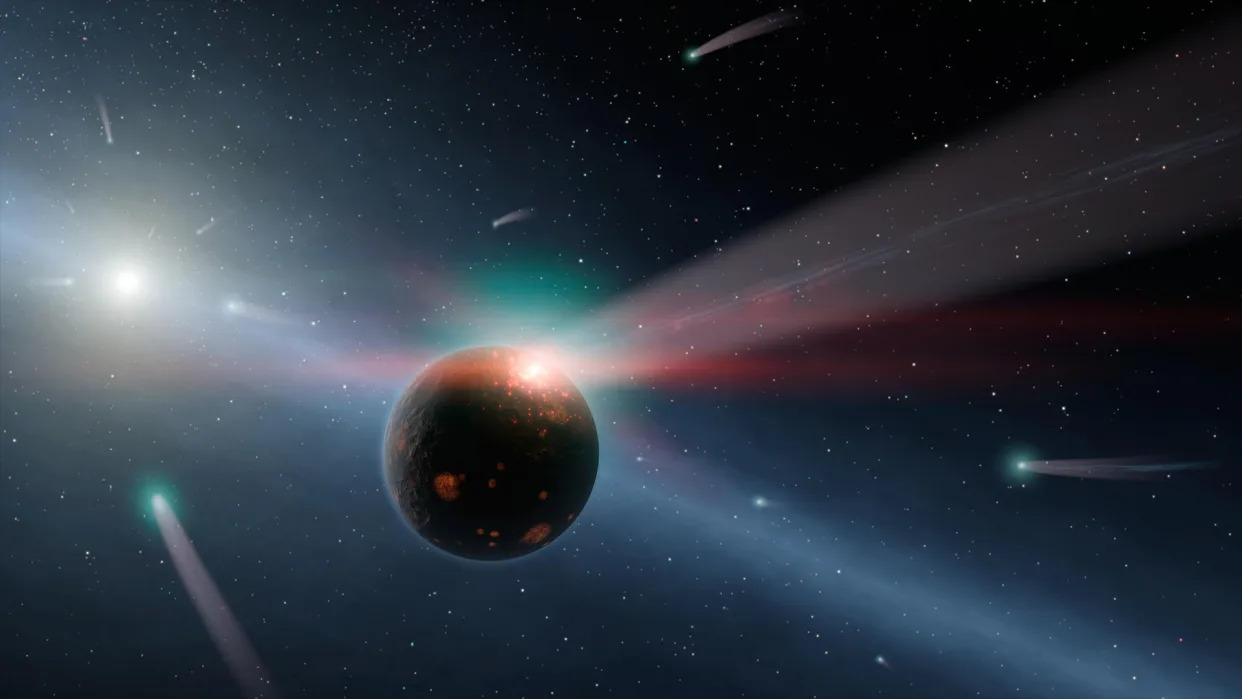
This artist conception illustrates a storm of comets around a star near our own, called Eta Corvi. Evidence for this barrage comes from NASA Spitzer Space Telescope infrared detectors.
The origin of life is one of the greatest scientific mysteries in the universe. Currently, there are two prevailing theories as to how it happened on Earth: The ingredients for life emerged from a primordial soup on our planet, or the molecules necessary for life were "seeded" here from elsewhere in the cosmos. With the latter theory in mind, a team of scientists has come up with a model for how this delivery could have occurred — and how it might happen on planets beyond our solar system.
In a paper published Nov. 14 in the journal Proceedings of the Royal Society A, the authors describe how "bouncing" comets could have distributed the raw ingredients for life — called prebiotic molecules — throughout star systems similar to our own. The team focused on simulating rocky exoplanets orbiting sun-size stars.
"It's possible that the molecules that led to life on Earth came from comets," Richard Anslow, an astronomer at the Cambridge Institute of Astronomy, said in a statement. "So the same could be true for planets elsewhere in the galaxy."
Related: Key building block for life discovered on distant asteroid Ryugu — and it could explain how life on Earth began
Tue, November 14, 2023

A comet flies through space above a large planet.
Scientists suspect that comets may have delivered the organic ingredients necessary to cook up life on Earth, and new research shows how exoplanets could have received these special deliveries from comets, too.
In its early history, Earth was bombarded with impacts from asteroids, comets and other cosmic bodies leftover from the formation of the solar system. Scientists still debate how the planet got its water and the molecules needed to form life, but comets are likely candidates.
But if comets could have potentially delivered the seeds of life to Earth, could they do the same for exoplanets elsewhere in the universe? With that question in mind, a team of researchers from University of Cambridge's Institute of Astronomy developed mathematical models that helped them show how comets could theoretically deliver similar building blocks of life to other planets in the Milky Way galaxy.
While the research is far from conclusive evidence for life on other worlds, the team's findings could help narrow down the search for life-hosting exoplanets.
"We're learning more about the atmospheres of exoplanets all the time, so we wanted to see if there are planets where complex molecules could also be delivered by comets," study author Richard Anslow from the University of Cambridge's Institute of Astronomy said in a statement. "It's possible that the molecules that led to life on Earth came from comets, so the same could be true for planets elsewhere in the galaxy."
Related: Comet 67P has the building blocks of life — smells like mothballs and almonds
In the last few decades, scientists have been learning more about the so-called "prebiotic molecules" found within comets that could have led to life. For example, in 2009, samples retrieved from Comet Wild 2 during NASA's Stardust mission were found to contain glycine, an amino acid and a building block of protein. The European Space Agency's Rosetta mission also detected organic molecules in the atmosphere of Comet 67P/Churyumov-Gerasimenko between 2014 and 2016.
But these organic molecules might get destroyed during a high-speed, high-temperature impact with a planet. That means Anslow and his colleagues had to find scenarios where a comet crash in another solar system would be slow enough for these the ingredients for life to survive intact.
For solar systems with stars similar to the sun, the lowest velocity impacts would be most likely in where multiple planets are tightly packed together, the researchers found through their simulations. Scientists have dubbed these types of planetary systems "peas-in-a-pod systems." A comet traveling from the outer reaches of such a system would get slowed down as it bounces between the orbits of these planets.
RELATED STORIES:
— See every comet photo (and more) from Europe's Rosetta probe
— Comet Impacts May Have Jump-Started Life on Earth
— Life May Be Common in the Milky Way, Thanks to Comet Swapping
Meanwhile, the team's simulations suggest there might be "unique challenges for life" on rocky planets surrounding red dwarf stars, officially known as M-dwarf stars. These are the most common stars in the galaxy and they have been a popular target for exoplanet-hunting astronomers.
But rocky planets in such a system also see more high-velocity impacts. A comet's chance at seeding life there could be doomed, especially if the planets are more widely spaced.
"It's exciting that we can start identifying the type of systems we can use to test different origin scenarios," Anslow said in a statement. "It's a different way to look at the great work that's already been done on Earth. What molecular pathways led to the enormous variety of life we see around us? Are there other planets where the same pathways exist? It's an exciting time, being able to combine advances in astronomy and chemistry to study some of the most fundamental questions of all."
This research was published today in the journal Proceedings of the Royal Society A.
'Bouncing' comets may be delivering the seeds of life to alien planets, new study finds
Joanna Thompson
Tue, November 14, 2023

This artist conception illustrates a storm of comets around a star near our own, called Eta Corvi. Evidence for this barrage comes from NASA Spitzer Space Telescope infrared detectors.
The origin of life is one of the greatest scientific mysteries in the universe. Currently, there are two prevailing theories as to how it happened on Earth: The ingredients for life emerged from a primordial soup on our planet, or the molecules necessary for life were "seeded" here from elsewhere in the cosmos. With the latter theory in mind, a team of scientists has come up with a model for how this delivery could have occurred — and how it might happen on planets beyond our solar system.
In a paper published Nov. 14 in the journal Proceedings of the Royal Society A, the authors describe how "bouncing" comets could have distributed the raw ingredients for life — called prebiotic molecules — throughout star systems similar to our own. The team focused on simulating rocky exoplanets orbiting sun-size stars.
"It's possible that the molecules that led to life on Earth came from comets," Richard Anslow, an astronomer at the Cambridge Institute of Astronomy, said in a statement. "So the same could be true for planets elsewhere in the galaxy."
Related: Key building block for life discovered on distant asteroid Ryugu — and it could explain how life on Earth began

A belt of comet-like bodies orbiting the white dwarf, similar to our solar system’s Kuiper Belt.
In recent decades, astronomers have proved that some comets and asteroids contain prebiotic molecules, including amino acids, hydrogen cyanide and vitamins, such as vitamin B3. While none of these organic compounds constitutes life in its own right, they are all necessary for life as we know it.
The researchers found that comets could, indeed, deliver intact prebiotic molecules directly to planets — but only under certain circumstances. First, the comet has to be traveling relatively slowly — at or below 9 miles per second (15 kilometers per second). Otherwise, the heat it would encounter while entering a planet's atmosphere would burn up the delicate organic molecules instantly. (For comparison, NASA estimates that Halley's Comet was moving at roughly 34 miles per second, or 55 km per second, during its last close approach to the sun, in 1986.)
The team calculated that the best place for comets to hit the cosmic brakes would be in "peas in a pod" systems, where a cluster of planets orbit in close proximity. This would cause an incoming comet to bounce from one planet's orbit to the next like a pinball. As it traveled, it would decelerate, until it eventually entered one planet's atmosphere slowly enough to deposit its prebiotic cargo. Crucially, the team also found that planets orbiting smaller stars or planets in less densely packed systems would be less likely to receive successful comet deliveries.
While this might not be the only avenue for life to arise in the galaxy, the researchers say their simulations could help give scientists a better idea of where to look for extraterrestrial life. And with more than 5,000 exoplanets discovered so far, narrowing down this search will become increasingly important.
"It's exciting that we can start identifying the type of systems we can use to test different origin scenarios," Anslow said. "It's an exciting time, being able to combine advances in astronomy and chemistry to study some of the most fundamental questions of all."
'Devil Comet' hurtling toward Earth is set to shine extra bright in North State skies
Jessica Skropanic, Redding Record Searchlight
Tue, November 14, 2023
A massive comet twice the size of Mt. Everest will hurtle past Earth in spring 2024.
The Devil Comet is making its first return since 1954, astronomers said.
And this comet has an ice volcano.
After a series of explosions that happened as recently as October, scientists now predict the comet will shine extra bright in North State skies.
How close will Devil Comet get to Earth?
Nicknamed for its two spiky “horns,” Devil Comet could be visible to the naked eye by April 21.
Astronomers predict it will be at its brightest on June 2, when it’s at its closest to Earth — but still 144 million miles away.
That’s about the distance between the sun and Mars, so we don’t have worry about this comet threatening Earth, according to astronomers: We can just sit back and watch what will hopefully be a stellar celestial show.
After that, Devil Comet won’t return for 71 years.

Photo of Comet Nishimura in September 2023.
Note to readers: If you appreciate the work we do here at the Redding Record Searchlight, please consider subscribing yourself or giving the gift of a subscription to someone you know.
Devil Comet has hot tails, cold volcano
One of the earliest known records of Devil Comet came from the Chinese more than 700 years ago. The comet got its official name, 12/P Pons-Brooks, after French astronomer Jean-Louis Pons and English astronomer William Robert Brooks spotted it in the 1800s, according to EarthSky.org.
Devil Comet belongs to an elite group of known cryovolcanic comets, meaning it has an ice volcano. Instead of molten rock, cryovolcanoes erupt water and ice, ammonia, methane and/or carbon dioxide. Those materials quickly freeze into distinctive shapes on the comet’s surface, according to NASA and Earth.com.
Sun-orbiting comets, like the Devil Comet and Halley’s Comet, are made of dust and ice. As they get close to the sun, the heat makes the comets and their long, streaking “tails” of gas and dust glow. Comet tails can stretch for millions of miles, according to NASA.
Since June 2022, astronomers reported violent eruptions on Devil Comet, some as recent as October. That means solar radiation is heating up the comet's core, making Devil Comet spew ice and gas clouds that formed its horn shapes, according to the British Astronomical Association.
“The outburst gave the comet a peculiar ‘horned’ appearance” resembling “the Millennium Falcon of ‘Star Wars.’ Woo hoo!,” Earthsky.org astronomy journalist Kelly Kizer Whitt wrote.
Why Devil Comet will fly past Earth, over North State, in 2024
Comets like Devil Comet “are leftovers from the formation of the solar system 4.6 billion years ago,” according to NASA.
Gravity from the sun or a planet can pull comets out of where they usually exist — in the Kuiper Belt beyond Neptune, or in the Oort Cloud. The latter is a sphere of loose particles of ice and dust at the outer edge of the solar system, NASA said.
Try to imagine a snow globe 50 times larger than the solar system.
The sun's gravitational pull can make a comet change course, sending it into a long oval orbit around the sun. “When the comet is in the inner solar system, either coming or going, that's when we may see it in our skies,” NASA said.
However, comet behavior is hard for scientists to predict since comets have wide orbits and sometimes move erratically. So how bright Devil Comet will be is a game of wait-and-see.
Best chances to see 12/P Pons-Brooks, AKA the Devil Comet
Best places to watch include rural areas away from city lights. Check ahead for safe stopping places including spots near Hat Creek, Burney, Shingletown, Mount Shasta and Dunsmuir, Yreka and near national parks and forests.
Keep in mind most parks close at dusk during their late spring and summer season.
For more information on comets go to NASA's SpacePlace at spaceplace.nasa.gov/comets/en.
Meteor showers to watch in November and December
You don't have to wait until 2024 to view something spectacular in North State skies.
Here are four meteor showers peaking as early as Thursday, Nov. 16.
Leonids Meteor Shower: Look to the southern sky to see the Leonids, peaking from Nov. 16 to 18. Best times to watch are between midnight and dawn. This meteor shower varies, with a few fizzling fireballs per hour some years, then pounding the atmosphere with hundreds other years. This year will likely be a lighter shower. Average meteors per hour: 10
Andromedid Meteor Shower: This little shower peaks in the late evening on Nov. 25 to 27. It's point of origin is the southern sky. Average meteors per hour: Five
Geminids Meteor Shower: Watch at any time of night to see this shower, peaking on Dec. 13 and 14. It originates from the northeastern sky. Average meteors per hour: 75
Ursids Meteor Shower: This brief little shower — originating from the northern sky — is from debris left by comet 108P/Tuttle. It peaks on Dec. 21 and 22. Best times to watch are from midnight to dawn. Average meteors per hour: Five
More: Newly-discovered comet, an eclipse, meteor showers and other sky wonders are on the way
Jessica Skropanic is a features reporter for the Record Searchlight/USA Today Network. She covers science, arts, social issues and news stories. Follow her on Twitter @RS_JSkropanic and on Facebook. Join Jessica in the Get Out! Nor Cal recreation Facebook group. To support and sustain this work, please subscribe today. Thank you.
This article originally appeared on Redding Record Searchlight: Star Wars spaceship-shaped comet to shine bright over Redding in 2024
Valerie Stimac, Austin Henderson
Wed, November 15, 2023

American geologist and astronaut Harrison Hagan Schmitt takes rock samples from the surface of the moon during America's last moon landing mission of the 20th century, Apollo 17, December 1972. Space Frontiers/Getty Images
Boldly glowing in the night sky, the moon has long been an object of fascination. It's not just a pretty face in our solar system; it's a natural satellite that affects the tides, animal sleep cycles (including humans!) and hormones.
But how long does it take to get to the moon? Humans have long been inspired to look up and reach beyond the atmosphere of our own planet — that's part of why President John F. Kennedy set his sights on NASA's mission objective to travel to the moon in the 1960s — so it's only natural to wonder how long the journey takes.
So far, American astronauts have made nine journeys to the moon — six of which landed on the lunar surface. NASA, other governments, and other private companies are now planning crewed missions back to the moon, which will give us even more data about how long it takes to make the trip.
The Moon's Distance: Not Just a Straight Line
The moon doesn't just lazily hover around Earth in a perfectly circular path. The moon's orbit is, in fact, elliptical.
This causes the moon to be sometimes closer to Earth (a point known as perigee) and sometimes further (known as apogee). This is why you might have heard the term "supermoon" thrown around.
Taking advantage of lunar orbit mechanics, astrophysicists can plan lunar missions to coincide with those times when the moon's elliptical orbit is at its closest point to Earth.
Travel Time to the Moon
Based on past missions, we know that it usually takes about three days for a manned spacecraft to reach the moon when the average distance from Earth to the moon is 240,000 miles (386,243 kilometers). This translates to a spacecraft's speed of about 3,333 mph (5,364 kph).
Yet, the duration isn't always set in stone. Some uncrewed missions, in a bid to be more fuel efficient, might move a lot slower. For instance, China's Chang'e missions took around four to five days.
But, want to hear something astonishing? The 1959 Luna 1, launched by a powerful rocket, made its journey to the moon in just 36 hours, traveling at a speed of about 6,500 mph (10,500 kph). However, it failed to land on the moon's surface.
The Luna 2, which launched only a few months later, not only succeeded in becoming the first spacecraft to land on the moon, but it also made the trip in 34 hours. And let's not forget the 2006 New Horizons, which breezed past the moon in a mere eight and a half hours en route to Pluto, reaching speeds of up to 36,373 mph (58,536 kph).
A Flashback to Apollo 11
The Apollo missions, headed by NASA from the Kennedy Space Center, were monumental in unraveling the mysteries of our lunar neighbor. The Apollo 11 mission showcases the wonders of orbital mechanics.
While it took Neil Armstrong, Buzz Aldrin and their team three days, three hours and 49 minutes to reach the moon and set foot on its surface, they returned to Earth in just two days, 22 hours and 56 minutes.
Why the time difference? As Armstrong and Aldrin were hopping around on the lunar surface, Earth and the moon grew slightly closer — an effect of that elliptical orbit we mentioned earlier. moon
What Lies Ahead: New Missions and New Hopes
With advancements in propulsion system and launch vehicle technologies, both governmental bodies and private enterprises are gearing up for future crewed missions to the moon. The European Space Agency, in collaboration with NASA's Orion spacecraft, aims to achieve newer milestones.
So, the next time you look up and see that silvery orb in the sky, just remember: A new chapter in our relationship with the moon is about to unfold with another crewed mission to its surface likely on the way.
This article was updated in conjunction with AI technology, then fact-checked and edited by a HowStuffWorks editor.
Original article: How Long Does It Take to Get to the Moon?
Copyright © 2023 HowStuffWorks, a division of InfoSpace Holdings, LLC, a System1 Company
SpaceX gets regulatory approval for megarocket, setting up Friday launch attempt
Jackie Wattles, CNN
Wed, November 15, 2023
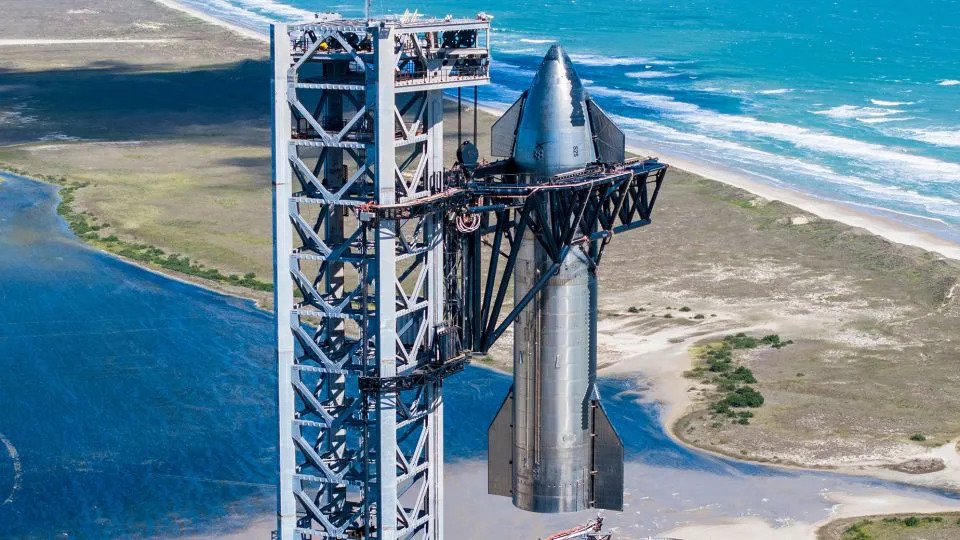
SpaceX/UPI/Shutterstock
Federal regulators have granted SpaceX permission to launch a long-awaited second test flight of its Starship system — the most powerful rocket ever built — following an explosive first attempt in April.
The Federal Aviation Administration, which licenses commercial rocket launches, said Wednesday that SpaceX has permission to launch the mission after the agency determined it “met all safety, environmental, policy and financial responsibility requirements.”
SpaceX’s website states that the company is targeting a two-hour launch window on Friday, November 17, that opens at 7 a.m. CT (8 a.m. ET).
Public notices issued to mariners indicate that backup opportunities for liftoff could include the mornings of November 18, 19 and 20.
The Starship spacecraft and its Super Heavy booster are at the center of SpaceX’s plans to eventually put humans on Mars, as well as aid NASA’s effort to return humans to the moon for the first time in more than 50 years. Starship is intended to serve as the lunar lander for the Artemis III mission, currently slated for 2025. And if the test flight once again fails, it could bog down NASA’s lunar exploration timeline.
April’s inaugural integrated test flight of Starship and Super Heavy — the massive rocket expected to propel the spacecraft to orbital speeds — ended just minutes after takeoff when the vehicle began tumbling tail-over-head, forcing SpaceX to initiate self-destruct mode and explode both rocket stages over the Gulf of Mexico.
SpaceX has spent the past several months rebuilding the launch site and making upgrades to the rocket system at the company’s Starbase facility in Boca Chica, Texas. The launchpad was torn to pieces by the sheer force of Super Heavy’s engines igniting, sending debris into the surrounding coastal area.
The rocket mishap’s potential impacts galvanized a group of environmental and wildlife advocates to file a May lawsuit againt the FAA, claiming the agency had failed to comply with federal environmental laws when it greenlit Starship’s first test flight.
William Gerstenmaier, SpaceX vice president for build and reliability, faulted regulators for holding up the second test flight, saying at a mid-October US Senate hearing, “It’s a shame when our hardware is ready to fly, and we’re not able to go fly because of regulations or review.”
The FAA finished its safety investigation in September, laying out 63 corrective actions for SpaceX. The agency then completed a safety review on October 31 for SpaceX’s planned second test flight.
However, as part of its environmental review, the FAA set up a consultation with the US Fish and Wildlife Service under the Endangered Species Act. That process concluded on November 14, according to a statement from the agency, allowing FAA to issue the launch permit.
Now, SpaceX is set for another attempt to propel Starship off the launchpad and send it on a mission to complete nearly one full lap of Earth.
Starship challenges
If the test mission once again fails, NASA’s aim to return humans to the moon’s surface could face delays as the space agency is racing other nations — including China — to build a permanent lunar settlement. The space agency has already warned that Starship might not be ready in time for a 2025 moon landing attempt.
Even if successful, SpaceX still has numerous technological hurdles to clear. The company must demonstrate the rocket can safely deliver a satellite or another payload to Earth’s orbit, as well as dock with a refueling tanker to top off its propellant while in orbit — a move that will be essential for getting the massive vehicle to the moon.
SpaceX CEO Elon Musk posted in August on social media that he foresees about a “50% probability of reaching orbital velocity,” though he cautiously added that “even getting to stage separation would be a win,” referring to the launch phase when the Super Heavy rocket detaches from the Starship spacecraft.
Environmental concerns
SpaceX may also face additional pushback from environmentalists ahead of — or in the wake of — the second launch attempt.
The group of environmental and wildlife advocates that previously sued the FAA could still attempt to seek an injunction to stop the next launch.
When reached for comment, Jared Margolis, a senior attorney at the Center for Biological Diversity, said the nonprofit group had not decided whether to pursue that route, though it recognized the option was still on the table. It’s not clear, however, whether the group will have enough time to file the proper paperwork before SpaceX moves forward with the anticipated launch.
This dead star is bursting back to life
Robert Lea
Wed, November 15, 2023 at 9:00 AM MST·4 min read
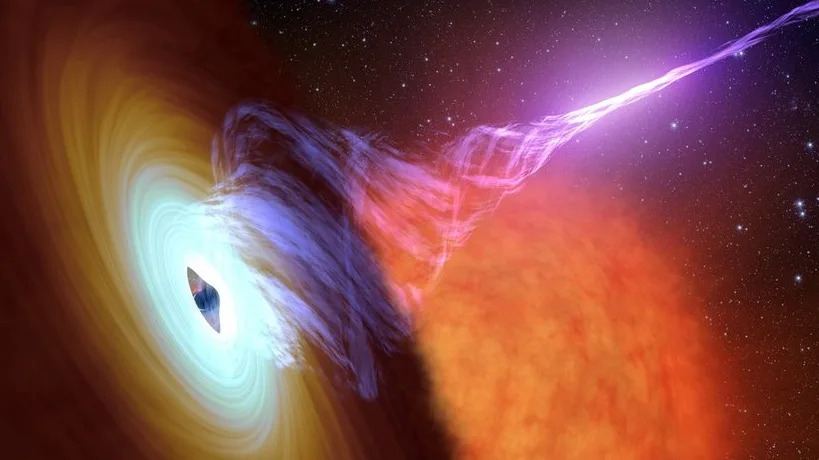
An illustration of a black hole swirling lots of matter around it and releasing a high level of brightness.
It would appear that a distant star has sprung back to life after its explosive death, blasting out repeated energetic flares over a period of several months that are like nothing astronomers have seen before.
Though each flash lasts just a few minutes even 100 days after the first eruption, they all remain as bright and as powerful as that original explosion — a rare type of stellar cataclysm called a "luminous fast blue optical transient" or LFBOT. This particular LFBOT is around a billion light-years from Earth and has been officially designated AT2022tsd, with its discoverers nicknaming it "the Tasmanian devil."
Far brighter than the usual explosions that mark the deaths of massive stars, LFBOTs also fading more rapidly postmortem, over the course of days rather than weeks. These extreme phenomena were first discovered in 2018, and in the half-decade since then, their origins have been shrouded in mystery. However, the Tasmanian devil's previously unseen flare activity might offer some answers., Spotted by 15 different telescopes across the globe, this behavior seems to indicate the engine driving LFBOTS is either a black hole or a neutron star — remnants left behind when truly huge stars die.
"We don’t think anything else can make these kinds of flares," Anna Y. Q. Ho, lead author of the research and an assistant professor of astronomy at Cornell University, said in a statement. "This settles years of debate about what powers this type of explosion and reveals an unusually direct method of studying the activity of stellar corpses."
Related: Hubble Space Telescope sees supernova wreckage in a hazy galaxy (image)
A new type of cosmic cataclysm
The Tasmanian Devil was first identified with software developed by Ho in Sept. 2022, as the system was sifting through data containing around half a million changing objects. or transients, detected via the Zwicky Transient Facility.
Following this, while routinely monitoring the LFBOT as it faded in Dec. 2022, Ho and her colleagues found a further bright spike of light coming from the event. The spike then promptly vanished.
"No one really knew what to say. We had never seen anything like that before — something so fast, and the brightness as strong as the original explosion months later — in any supernova or FBOT,” Ho said. "We’d never seen that, period, in astronomy."
To investigate this unexpected sort of "return to life" by the Tasmanian Devil, the team gathered observations from another 12 telescopes, including one that captured the event with a high-speed camera. After ruling out other possible light sources, the researchers were left with 14 irregular light pulses that happened over 120 days. This may just be a fraction of the total flares from the whole event, Ho believes.
"Amazingly, instead of fading steadily as one would expect, the source briefly brightened again — and again and again," she said. "LFBOTs are already a kind of weird, exotic event, so this was even weirder."
Related Stories:
— Record-breaking 'BOAT' gamma-ray burst continues to amaze scientists
— Cosmic Photos: Zwicky Transient Facility First Light
— Hubble Telescope just witnessed a massive intergalactic explosion and astronomers can't explain it
Ho and colleagues now intend to investigate the processes driving these blasts of light. The current prime suspects are jets of matter funneled by a black hole's magnetic field, which get blasted out at light-like speeds currently prime suspects. However, the possibility remains that LFBOTs could result from colliding and merging black holes.
"We might be seeing a completely different channel for cosmic cataclysms," Ho said.
The research could ultimately help reveal more about how stars die, as well as the types of stellar remnants they leave behind. In essence, LFBOTs may offer the chance to observe stars as they transition from "life" to "death."
"Because the corpse is not just sitting there; it’s active and doing things that we can detect," Ho said. "We think these flares could be coming from one of these newly formed corpses, which gives us a way to study their properties when they’ve just been formed."
The team’s research was published on Wednesday (Nov. 15) in the journal Nature.
NASA captures stunning photos of sun's rays over Earth: See the jaw-dropping images
Brittany Kasko
Wed, November 15, 2023
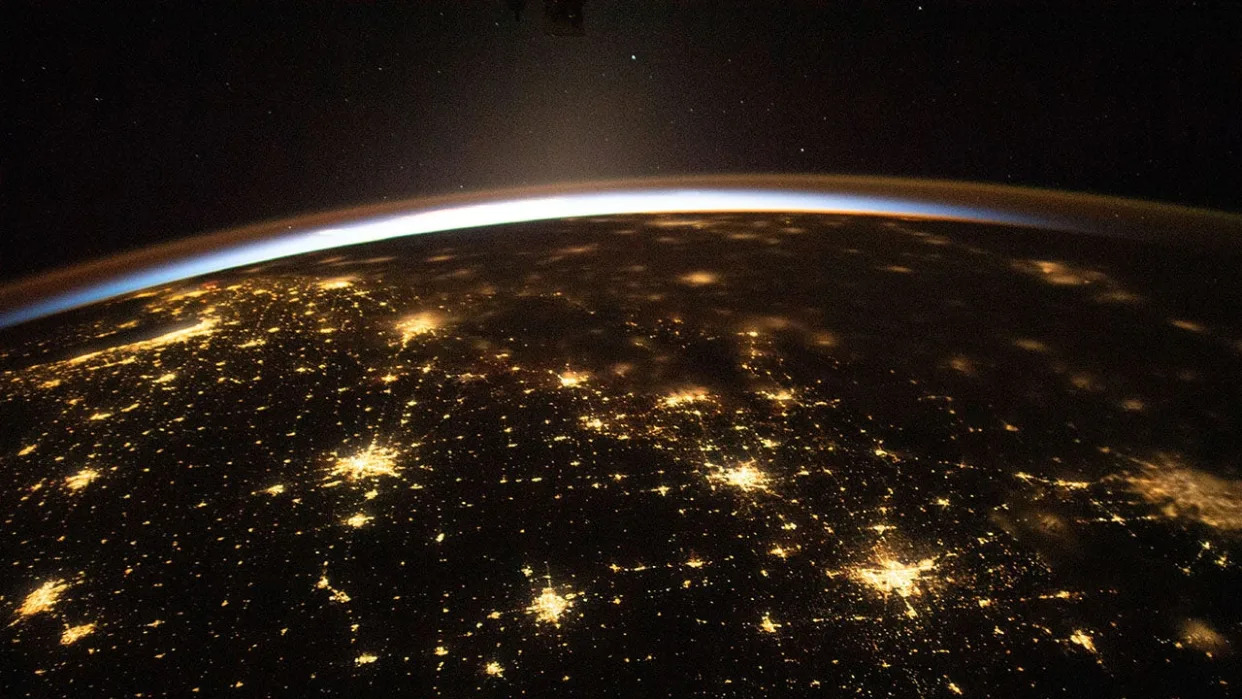
NASA captures stunning photos of sun's rays over Earth: See the jaw-dropping images
NASA released images of Earth from a unique angle that might cause most people to stop and stare.
Rays from the sun were captured lighting up Earth’s atmosphere in a newly released image from the International Space Station.
The images were taken about 260 miles above the central United States, according to NASA.
NASA RELEASES NEW IMAGE OF EARTH TAKEN FROM SPACE DURING ANNULAR SOLAR ECLIPSE: SEE THE STUNNING SHOT
On the far left of the images, some of the lights from Chicago can be seen, while outlined by Lake Michigan.

Image captured of the sun illuminating the Earth from the International Space Station.
NASA also pointed out that on the far right are the city lights of the Dallas Fort Worth metropolitan area, emerging through some clouds.
NASA astronaut Jasmin Moghbeli took the images at the International Space Station, as SWNS reported.
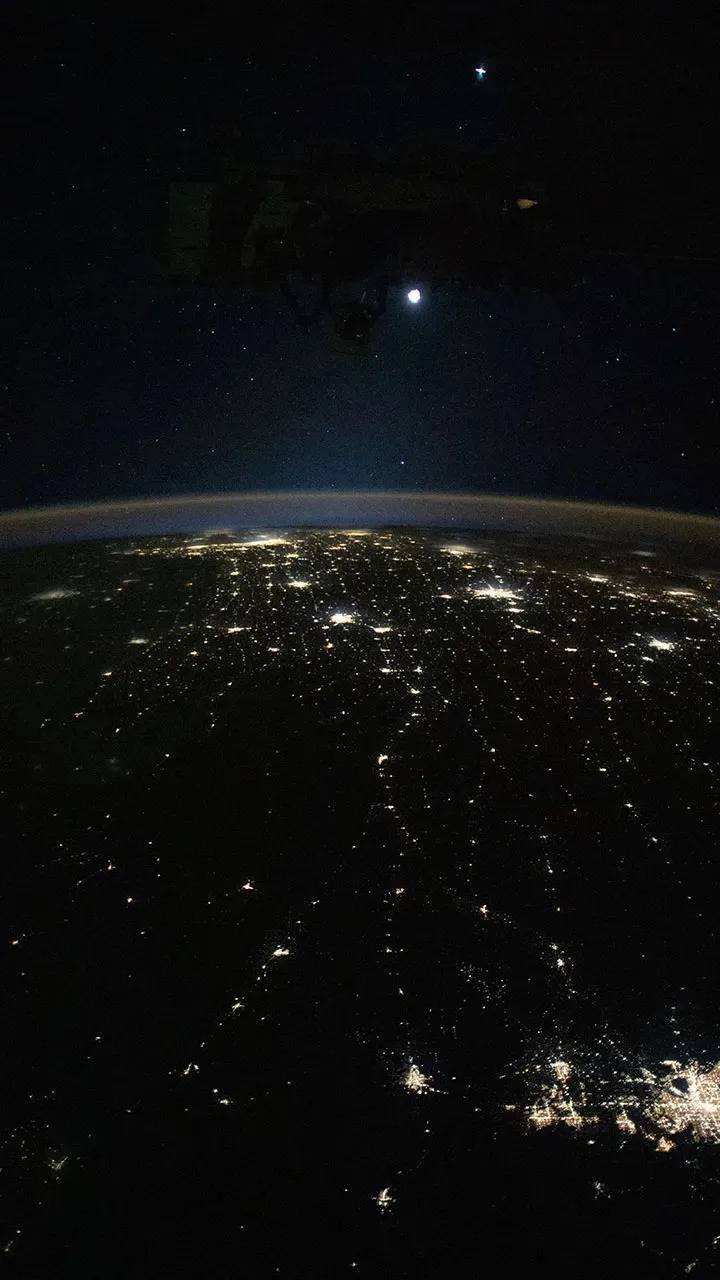
Earth's airglow outlines the planet's horizon with the moon above in this photograph from the International Space Station as it orbited 260 miles above the midwestern United States.
The Nov. 10 photographs show the Earth and the moon off in the distance.
The images also show an aurora at the far right of the image, according to NASA.
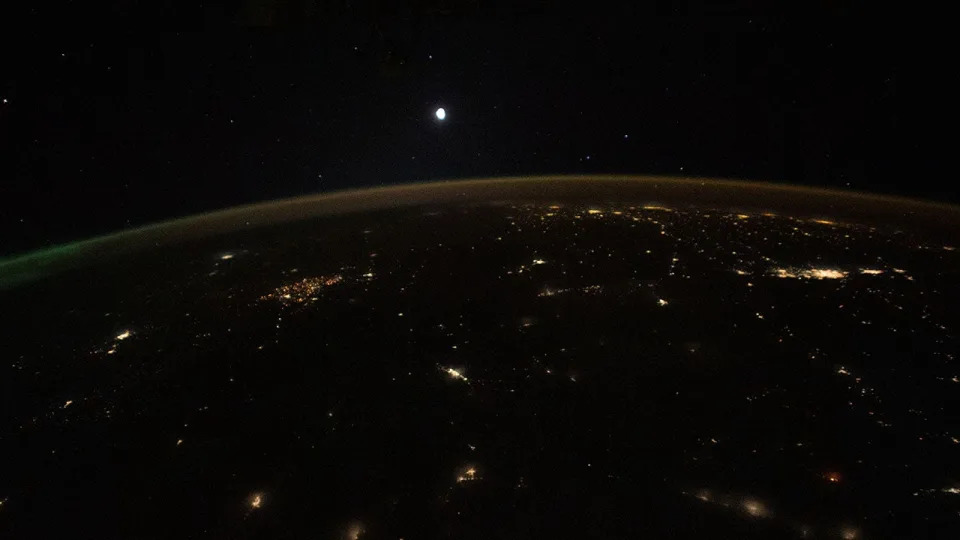
The moon is pictured above Earth's horizon, as is its airglow and an aurora (at far right) in this photograph from the International Space Station.
The U.S. Marine Corps test pilot picked out other jaw-dropping images during her mission to the International Space Station, according to SWNS.
Original article source: NASA captures stunning photos of sun's rays over Earth: See the jaw-dropping images
New SpaceX video shows the company gearing up to launch the world's most powerful rocket to space after its first attempt ended in flames
Wed, November 15, 2023 at 9:00 AM MST·4 min read

An illustration of a black hole swirling lots of matter around it and releasing a high level of brightness.
It would appear that a distant star has sprung back to life after its explosive death, blasting out repeated energetic flares over a period of several months that are like nothing astronomers have seen before.
Though each flash lasts just a few minutes even 100 days after the first eruption, they all remain as bright and as powerful as that original explosion — a rare type of stellar cataclysm called a "luminous fast blue optical transient" or LFBOT. This particular LFBOT is around a billion light-years from Earth and has been officially designated AT2022tsd, with its discoverers nicknaming it "the Tasmanian devil."
Far brighter than the usual explosions that mark the deaths of massive stars, LFBOTs also fading more rapidly postmortem, over the course of days rather than weeks. These extreme phenomena were first discovered in 2018, and in the half-decade since then, their origins have been shrouded in mystery. However, the Tasmanian devil's previously unseen flare activity might offer some answers., Spotted by 15 different telescopes across the globe, this behavior seems to indicate the engine driving LFBOTS is either a black hole or a neutron star — remnants left behind when truly huge stars die.
"We don’t think anything else can make these kinds of flares," Anna Y. Q. Ho, lead author of the research and an assistant professor of astronomy at Cornell University, said in a statement. "This settles years of debate about what powers this type of explosion and reveals an unusually direct method of studying the activity of stellar corpses."
Related: Hubble Space Telescope sees supernova wreckage in a hazy galaxy (image)
A new type of cosmic cataclysm
The Tasmanian Devil was first identified with software developed by Ho in Sept. 2022, as the system was sifting through data containing around half a million changing objects. or transients, detected via the Zwicky Transient Facility.
Following this, while routinely monitoring the LFBOT as it faded in Dec. 2022, Ho and her colleagues found a further bright spike of light coming from the event. The spike then promptly vanished.
"No one really knew what to say. We had never seen anything like that before — something so fast, and the brightness as strong as the original explosion months later — in any supernova or FBOT,” Ho said. "We’d never seen that, period, in astronomy."
To investigate this unexpected sort of "return to life" by the Tasmanian Devil, the team gathered observations from another 12 telescopes, including one that captured the event with a high-speed camera. After ruling out other possible light sources, the researchers were left with 14 irregular light pulses that happened over 120 days. This may just be a fraction of the total flares from the whole event, Ho believes.
"Amazingly, instead of fading steadily as one would expect, the source briefly brightened again — and again and again," she said. "LFBOTs are already a kind of weird, exotic event, so this was even weirder."
Related Stories:
— Record-breaking 'BOAT' gamma-ray burst continues to amaze scientists
— Cosmic Photos: Zwicky Transient Facility First Light
— Hubble Telescope just witnessed a massive intergalactic explosion and astronomers can't explain it
Ho and colleagues now intend to investigate the processes driving these blasts of light. The current prime suspects are jets of matter funneled by a black hole's magnetic field, which get blasted out at light-like speeds currently prime suspects. However, the possibility remains that LFBOTs could result from colliding and merging black holes.
"We might be seeing a completely different channel for cosmic cataclysms," Ho said.
The research could ultimately help reveal more about how stars die, as well as the types of stellar remnants they leave behind. In essence, LFBOTs may offer the chance to observe stars as they transition from "life" to "death."
"Because the corpse is not just sitting there; it’s active and doing things that we can detect," Ho said. "We think these flares could be coming from one of these newly formed corpses, which gives us a way to study their properties when they’ve just been formed."
The team’s research was published on Wednesday (Nov. 15) in the journal Nature.
NASA captures stunning photos of sun's rays over Earth: See the jaw-dropping images
Brittany Kasko
Wed, November 15, 2023

NASA captures stunning photos of sun's rays over Earth: See the jaw-dropping images
NASA released images of Earth from a unique angle that might cause most people to stop and stare.
Rays from the sun were captured lighting up Earth’s atmosphere in a newly released image from the International Space Station.
The images were taken about 260 miles above the central United States, according to NASA.
NASA RELEASES NEW IMAGE OF EARTH TAKEN FROM SPACE DURING ANNULAR SOLAR ECLIPSE: SEE THE STUNNING SHOT
On the far left of the images, some of the lights from Chicago can be seen, while outlined by Lake Michigan.

Image captured of the sun illuminating the Earth from the International Space Station.
NASA also pointed out that on the far right are the city lights of the Dallas Fort Worth metropolitan area, emerging through some clouds.
NASA astronaut Jasmin Moghbeli took the images at the International Space Station, as SWNS reported.

Earth's airglow outlines the planet's horizon with the moon above in this photograph from the International Space Station as it orbited 260 miles above the midwestern United States.
The Nov. 10 photographs show the Earth and the moon off in the distance.
The images also show an aurora at the far right of the image, according to NASA.

The moon is pictured above Earth's horizon, as is its airglow and an aurora (at far right) in this photograph from the International Space Station.
The U.S. Marine Corps test pilot picked out other jaw-dropping images during her mission to the International Space Station, according to SWNS.
Original article source: NASA captures stunning photos of sun's rays over Earth: See the jaw-dropping images
New SpaceX video shows the company gearing up to launch the world's most powerful rocket to space after its first attempt ended in flames
Marianne Guenot,Morgan McFall-Johnsen,Jenny McGrath
Tue, November 14, 2023
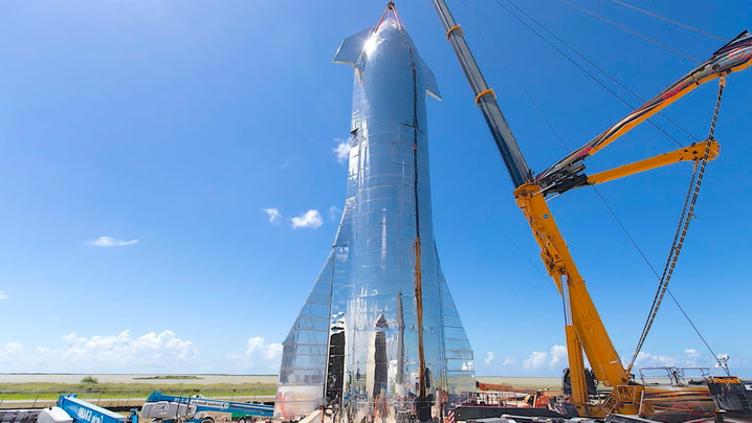
Scroll back up to restore default view.
SpaceX's Starship is prepping for a second test flight on November 17.
On its first test flight, the mega-rocket exploded four minutes after liftoff.
SpaceX made four major changes to help it reach orbit for the first time.
SpaceX is gearing up to try and launch its Starship megarocket to space for a second time. Pending regulatory approval, the launch could take place on November 17, the company announced on X.
SpaceX, founded by CEO Elon Musk, has made crucial upgrades since the rocket's last launch in April when Starship blew up mid-air and blasted a crater through its launchpad that sprayed debris so far it rained on a small town about 5 miles away, Insider previously reported.
But SpaceX isn't planning on repeating that scenario this time. The company made more than a thousand changes to the rocket since April and it is now "ready to launch" again, Musk said in September. The company recently highlighted some of those upgrades in a video it released in preparation for the upcoming launch.
The new features, some of which are huge installations, could help the world's largest and most powerful rocket finally reach orbit for the first time.
The stakes are high. Musk is counting on Starship to establish a human settlement on Mars. The company has also received billions of dollars from NASA to put humans back on the moon for the first time in more than 50 years.
Here are four of the biggest modifications to the rocket, explained by a former SpaceX mission director.
Tue, November 14, 2023

Scroll back up to restore default view.
SpaceX's Starship is prepping for a second test flight on November 17.
On its first test flight, the mega-rocket exploded four minutes after liftoff.
SpaceX made four major changes to help it reach orbit for the first time.
SpaceX is gearing up to try and launch its Starship megarocket to space for a second time. Pending regulatory approval, the launch could take place on November 17, the company announced on X.
SpaceX, founded by CEO Elon Musk, has made crucial upgrades since the rocket's last launch in April when Starship blew up mid-air and blasted a crater through its launchpad that sprayed debris so far it rained on a small town about 5 miles away, Insider previously reported.
But SpaceX isn't planning on repeating that scenario this time. The company made more than a thousand changes to the rocket since April and it is now "ready to launch" again, Musk said in September. The company recently highlighted some of those upgrades in a video it released in preparation for the upcoming launch.
The new features, some of which are huge installations, could help the world's largest and most powerful rocket finally reach orbit for the first time.
The stakes are high. Musk is counting on Starship to establish a human settlement on Mars. The company has also received billions of dollars from NASA to put humans back on the moon for the first time in more than 50 years.
Here are four of the biggest modifications to the rocket, explained by a former SpaceX mission director.
1. SpaceX added a vent between the rocket and the booster to try a risky new maneuver

A vent and heat shields were added between the spaceship and the booster.SpaceX/Insider
SpaceX has added a vent between the two stages of its rocket. This is evidence of a bold change for its next flight: hot staging.
SpaceX's enormous Starship mega-rocket is made of two stages: the Starship spaceship and its booster, the Super Heavy booster.
The booster generates an immense amount of thrust, heaving the entire system off the ground and through the thickest parts of Earth's atmosphere. The spaceship then separates from the booster miles above the ground to fly off on its own.
Typically, on traditional rockets "the main engines on the booster stage come to a stop, then the second stage lights up after it's been separated," Abhi Tripathi, a former mission director for SpaceX's Dragon spaceship, told Insider.
But for Starship's next launch, the spaceship will start igniting its engines "while still essentially connected" to its booster, said Tripathi, who is now Director of Mission Operations at the University of California's Berkeley's Space Sciences Laboratory.
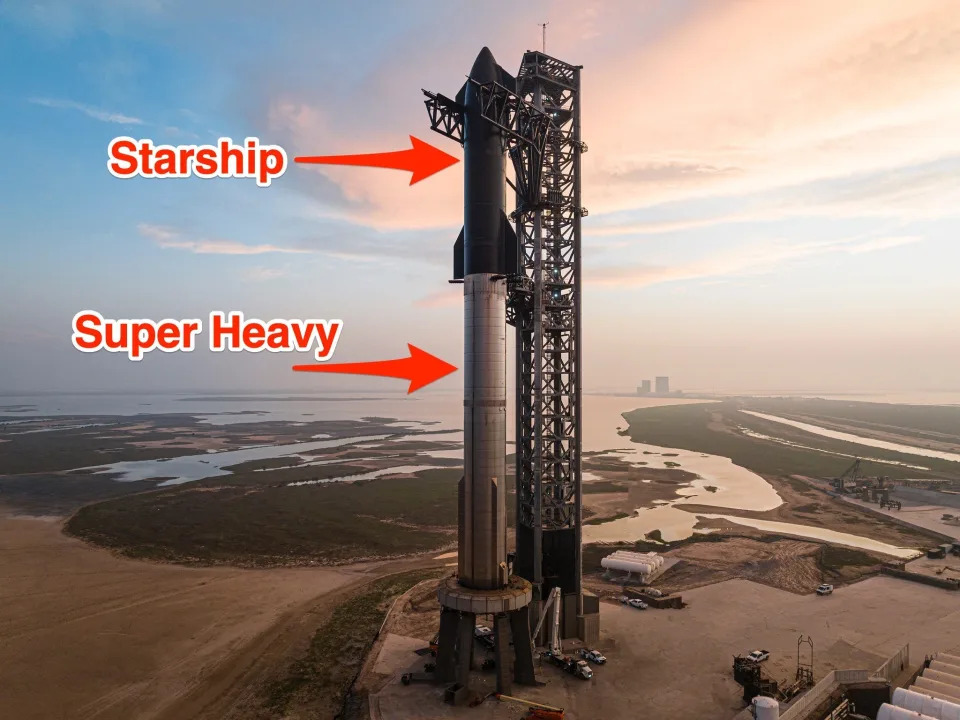
The Starship-Super Heavy launch system is made up of two stages.SpaceX
That's why Starship added the vents — and heavy-duty heat shields — to the top of the booster, so the flames can escape and the rocket doesn't "just blow itself up," Musk told journalist Ashlee Vance in a live interview on X in June.
The upside of this approach is that it gives the spaceship a small but significant boost, increasing the rocket's payload by about 10%, Musk told Vance.
The tradeoff is that hot staging might put the booster at more risk from the flames, a counter-intuitive move for a company that aims to reuse its booster, Tripathi said.
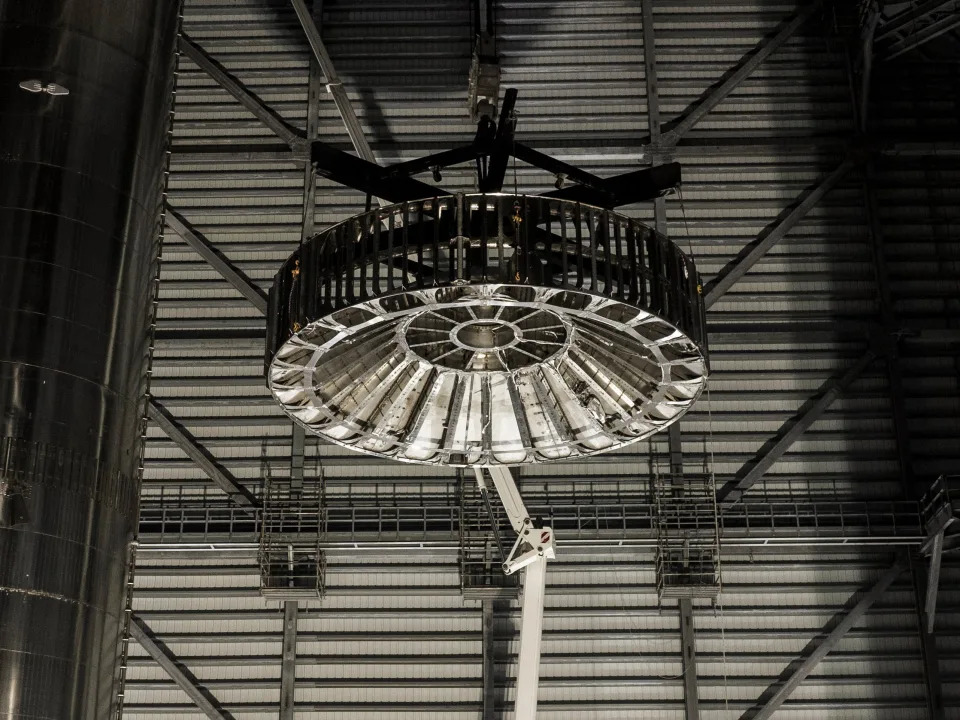
SpaceX placed this heat shield between the Starship space ship and its booster.SpaceX
So why did SpaceX decide to take the potential risk? Engineers may have decided it was worth it for better performance, Tripathi said.
2. New protection against booster damage
To the casual observer, the first Starship test flight was going amazingly well until the rocket suddenly burst into flames. But there were clues that something was going wrong long before the explosion.

Screengrabs from Starship's April flight show three engines off at the beginning, two shutting down mid-flight, and another flickering on and off.SpaceX/Insider
The live stream of the flight included a diagram of the rocket's 33 raptor engines. This showed two engines dying during the flight, and a third flickered off and on, on top of three that were off from the get-go.
A few engine failures during a flight is no big deal — Starship is so powerful, it could still make it to orbit with less than full thrust, said Tripathi.
But it was a symptom that something was going awry in the booster. A statement later published by SpaceX explained that a fuel leak inside the booster had caused fires. Because of this, SpaceX lost communication with the rocket's primary flight computer "and, ultimately, control of the vehicle," per the statement.
"If something cascades from the engine to knock out the smarts of your rocket, that's not good," said Tripathi.
The bigger picture here is that SpaceX probably underestimated the shielding needed to bolster its rocket from the power of its own engines, Tripathi said.
To address this, SpaceX has likely had to add more protection to the components in the booster, Tripathi said. The company said it was adding more systems to control fires onboard.
All of this adds weight, which may have contributed to the decision to move to hot staging, per Tripathi.
3. A safer self-destruct system?
Wild cheers let off by SpaceX engineers fell to worried hushes at around 2 minutes 45 seconds into the test flight.
The rocket was due to have separated from its booster, but it had clearly failed. For about a minute, it tumbled out of control, before it burst into a huge fireball.
But that explosion didn't happen immediately, and that is a big problem.
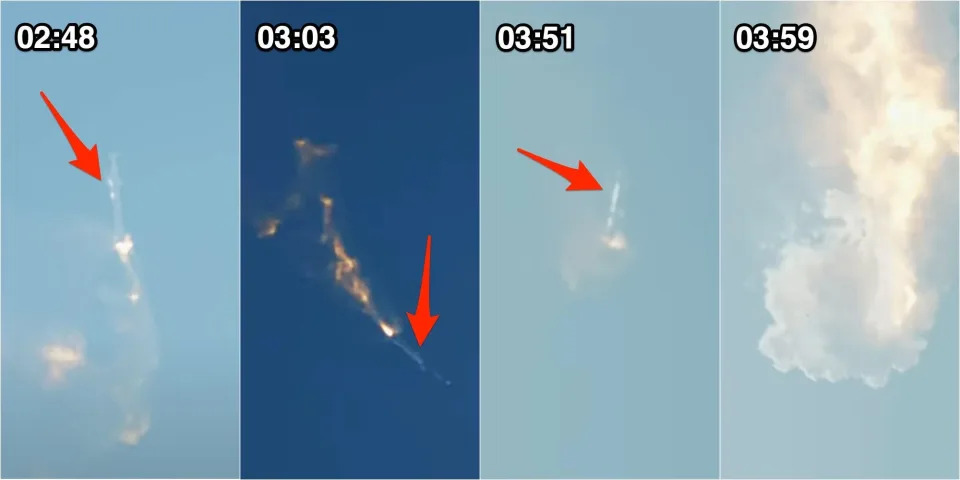
Starship was seen tumbling before it burst into a fireball on its first integrated flight.SpaceX/Insider.
Starship is fitted with a self-destruct system, which automatically detects when something is going wrong. That system — called the Autonomous Flight Safety System (AFSS) — did set off explosives in the rocket, but only after an "unexpected delay," SpaceX said in a statement on September 8.
This means the AFSS system did not work as it should have, a matter that would have been taken very seriously by the FAA.
SpaceX is not allowed to share much about the improvements for security reasons, Tripathi said. But the company has confirmed it has "enhanced and requalified the AFSS to improve system reliability."
4. A 'gigantic upside-down shower head' on the launchpad
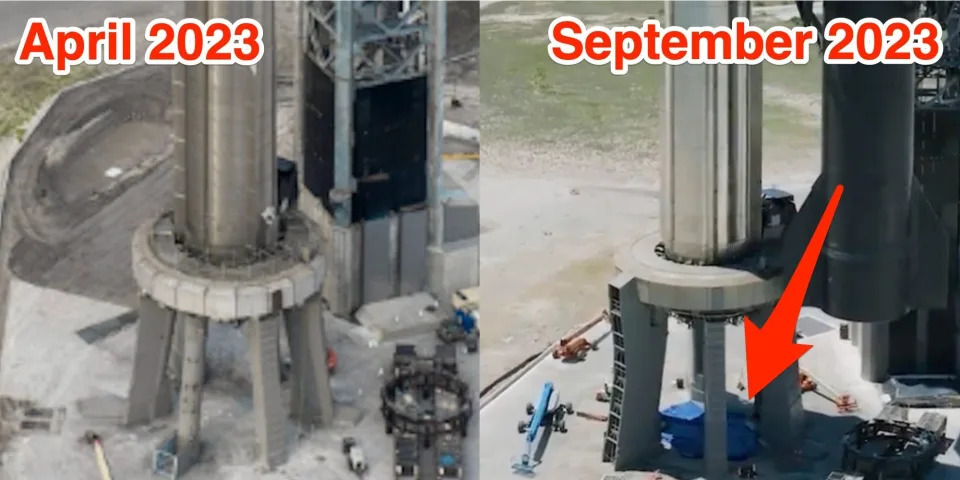
SpaceX added a flooding system to its launchpad to avoid fire and heat damage (in this picture, it is covered with a blue tarp).SpaceX/Insider
During its April launch, the rocket blasted through its launchpad, sending fragments of concrete and other debris flying around the launch site in Boca Chica, Texas.
The debris was spread across 385 acres, including some state park land, and the launch also ignited a 3.5-acre fire in a state park to the south, Bloomberg previously reported.
This angered local environmental groups who filed a lawsuit against the FAA over their oversight of the launch.

A picture shows a crater left by SpaceX's Starship after taking off in April.LabPadre/YouTube
The problem, Tripathi said, is that SpaceX hasn't built a flame diverter at Boca Chica. A flame diverter is made up of a series of huge tunnels typically built under launchpads to direct flames hundreds of yards away.
It's not immediately clear why this hasn't been done, but it could have to do with the fact Starbase is located near a nature reserve, said Tripathi.
Instead, for Starship's maiden test flight, SpaceX decided to see if they could absorb the force of the flames with a thick concrete launchpad alone.
"As we all saw, that calculation did not go right," said Tripathi.
Ahead of the next launch, SpaceX has decided to tweak its approach by adding what Musk called a "water-cooled steel sandwich" to the pad, he told Vance in June.
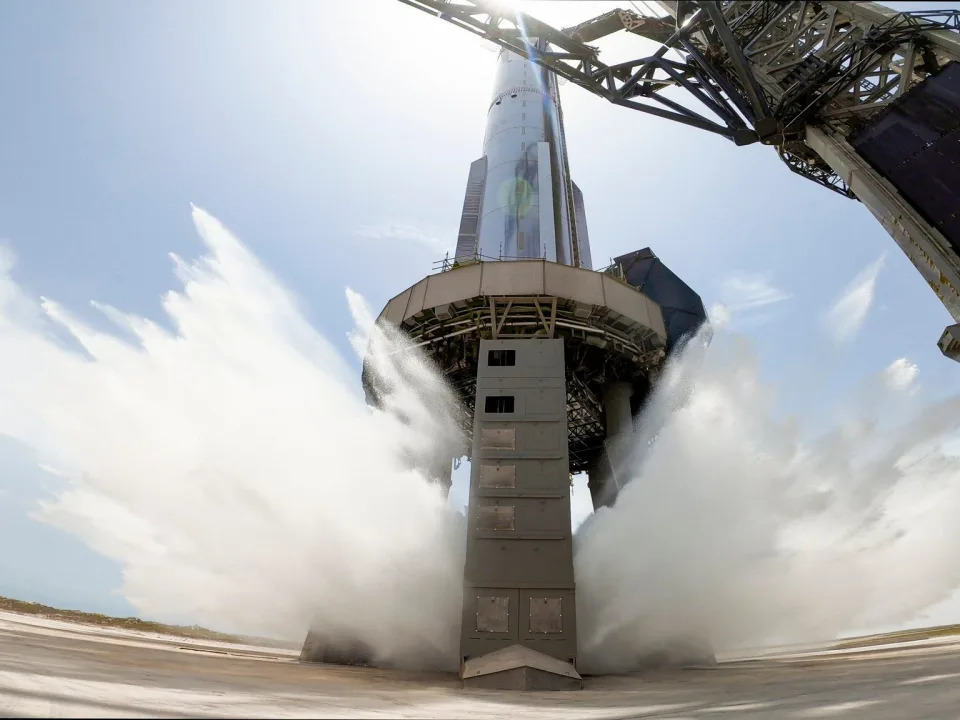
SpaceX demonstrating its new water deluge system on the Starship launchpad.SpaceX
The pad has now been fitted with two thick steel plates along with a water deluge system — essentially a "gigantic upside-down shower head" Musk told Vance.
"It's going to basically blast water upwards while the rocket is over the pad to counteract the massive amount of heat from the booster," he told Vance.
The launchpad has also been reinforced with 35,300 cubic feet of high-strength concrete,
This approach has raised concerns of its own, as the water used to cool the pad could constitute "industrial process water" which is tightly regulated in the US, CNBC previously reported.
The Texas Commission on Environmental Quality (TCEQ) told CNBC that SpaceX had not applied for permits to regulate that water, adding there was "no determination" made as to whether the activity violated environmental laws
The FAA has given the all-clear, but will Starship fly?
Over four months after the first launch, the FAA has said it is ready to allow SpaceX to fly again.
A mishap investigation launched after April's aborted test flight — standard procedure when a flight doesn't go to plan — has now been closed, and SpaceX has likely already made the changes the agency required, Tripathi said.
Acting Administrator Polly Trottenberg told reporters in September the FAA is "optimistic" a launch license could be issued "sometime next month," per Reuters.
"Was just informed that approval to launch should happen in time for a Friday launch," Musk posted on social media on November 13. It's unclear if that approval referred to the FAA, per CNBC.

SpaceX has built multiple Starships and Super Heavy boosters.SpaceX
The FAA needed to review the changes made to the Starship launch system before it granted a new license. This includes an environmental review of the new launchpad system, the administration told Insider in an email.
The lawsuit raised against the FAA's handling of Starship's environmental review could also cause delays. This case "has the potential to delay launches, but only if we bring a motion for an injunction, which we have not done yet," Jared M. Margolis, a Senior Attorney for Center for Biological Diversity, one of the plaintiffs in the case against the FAA, told Insider in September.
Correction: September 19, 2023 — An earlier version of this article misstated the reason that Tripathi thinks SpaceX switched to hot staging. He thinks the company may have done it for performance gains, not necessarily because new booster reinforcements made Super Heavy heavier.
The universe is expanding faster than theory predicts – physicists are searching for new ideas that might explain the mismatch
Ryan Keeley, University of California, Merced
Wed, November 15, 2023
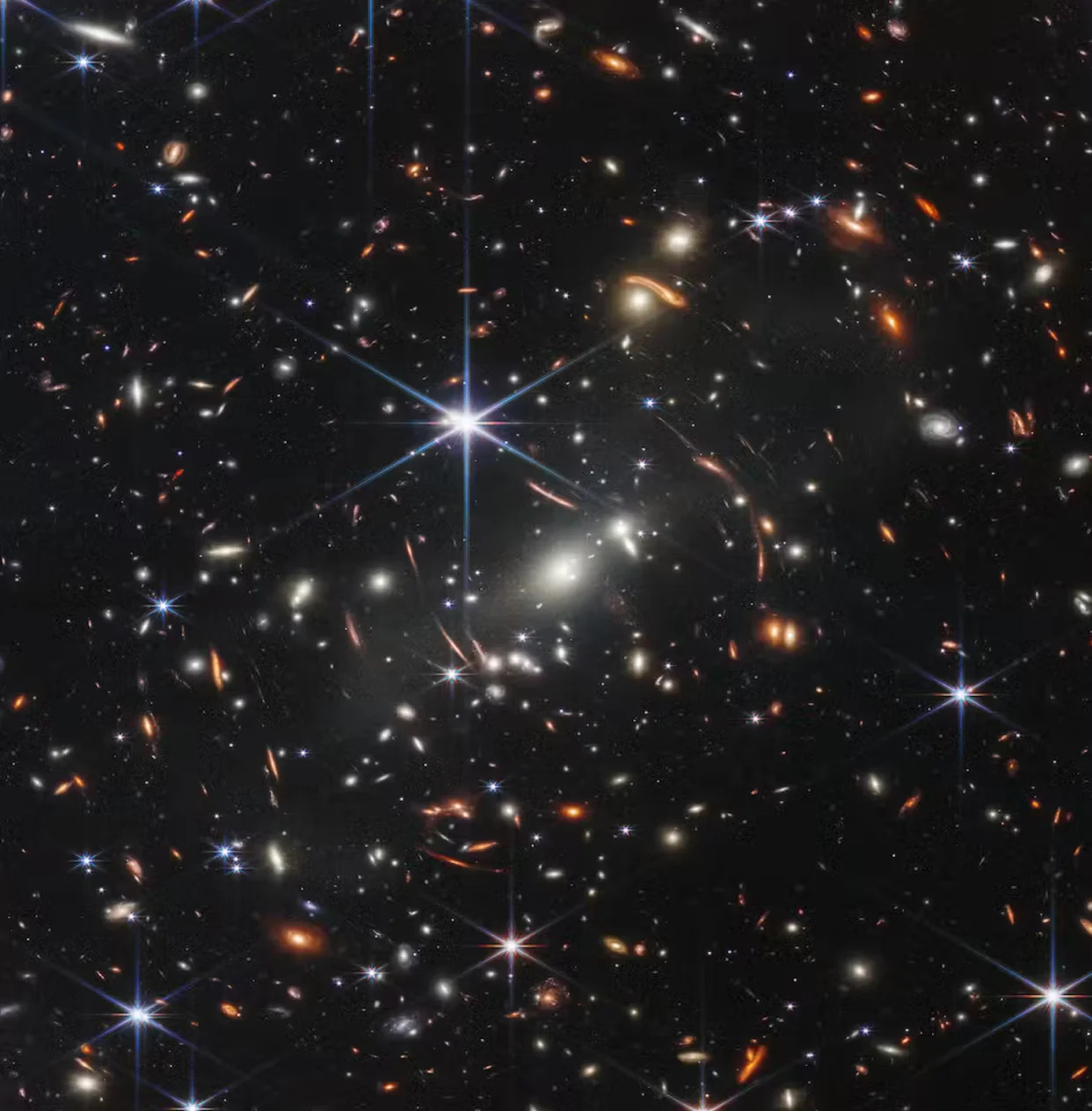
The James Webb Space Telescope's deep field image shows a universe full of sparkling galaxies. NASA/STScI
Astronomers have known for decades that the universe is expanding. When they use telescopes to observe faraway galaxies, they see that these galaxies are moving away from Earth.
To astronomers, the wavelength of light a galaxy emits is longer the faster the galaxy is moving away from us. The farther away the galaxy is, the more its light has shifted toward the longer wavelengths on the red side of the spectrum – so the higher the “redshift.”
Because the speed of light is finite, fast, but not infinitely fast, seeing something far away means we’re looking at the thing how it looked in the past. With distant, high-redshift galaxies, we’re seeing the galaxy when the universe was in a younger state. So “high redshift” corresponds to the early times in the universe, and “low redshift” corresponds to the late times in the universe.
But as astronomers have studied these distances, they’ve learned that the universe is not just expanding – its rate of expansion is accelerating. And that expansion rate is even faster than the leading theory predicts it should be, leaving cosmologists like me puzzled and looking for new explanations.
Dark energy and a cosmological constant
Scientists call the source of this acceleration dark energy. We’re not quite sure what drives dark energy or how it works, but we think its behavior could be explained by a cosmological constant, which is a property of spacetime that contributes to the expansion of the universe.
Albert Einstein originally came up with this constant – he marked it with a lambda in his theory of general relativity. With a cosmological constant, as the universe expands, the energy density of the cosmological constant stays the same.
Imagine a box full of particles. If the volume of the box increases, the density of particles would decrease as they spread out to take up all the space in the box. Now imagine the same box, but as the volume increases, the density of the particles stays the same.
It doesn’t seem intuitive, right? That the energy density of the cosmological constant does not decrease as the universe expands is, of course, very weird, but this property helps explain the accelerating universe.
A standard model of cosmology
Right now, the leading theory, or standard model, of cosmology is called “Lambda CDM.” Lambda denotes the cosmological constant describing dark energy, and CDM stands for cold dark matter. This model describes both the acceleration of the universe in its late stages as well as the expansion rate in its early days.
Specifically, the Lambda CDM explains observations of the cosmic microwave background, which is the afterglow of microwave radiation from when the universe was in a “hot, dense state” about 300,000 years after the Big Bang. Observations using the Planck satellite, which measures the cosmic microwave background, led scientists to create the Lambda CDM model.
Fitting the Lambda CDM model to the cosmic microwave background allows physicists to predict the value of the Hubble constant, which isn’t actually a constant but a measurement describing the universe’s current expansion rate.
But the Lambda CDM model isn’t perfect. The expansion rate scientists have calculated by measuring distances to galaxies, and the expansion rate as described in Lambda CDM using observations of the cosmic microwave background, don’t line up. Astrophysicists call that disagreement the Hubble tension.

The universe is expanding faster than predicted by popular models in cosmology. NASA
The Hubble tension
Over the past few years, I’ve been researching ways to explain this Hubble tension. The tension may be indicating that the Lambda CDM model is incomplete and physicists should modify their model, or it could indicate that it’s time for researchers to come up with new ideas about how the universe works. And new ideas are always the most exciting things for a physicist.
One way to explain the Hubble tension is to modify the Lambda CDM model by changing the expansion rate at low redshift, at late times in the universe. Modifying the model like this can help physicists predict what sort of physical phenomena might be causing the Hubble tension.
For instance, maybe dark energy is not a cosmological constant but instead the result of gravity working in new ways. If this is the case, dark energy would evolve as the universe expands – and the cosmic microwave background, which shows what the universe looked like only a few years after its creation, would have a different prediction for the Hubble constant.
But, my team’s latest research has found that physicists can’t explain the Hubble tension just by changing the expansion rate in the late universe – this whole class of solutions falls short.
Developing new models
To study what types of solutions could explain the Hubble tension, we developed statistical tools that enabled us to test the viability of the entire class of models that change the expansion rate in the late universe. These statistical tools are very flexible, and we used them to match or mimic different models that could potentially fit observations of the universe’s expansion rate and might offer a solution to the Hubble tension.
The models we tested include evolving dark energy models, where dark energy acts differently at different times in the universe. We also tested interacting dark energy-dark matter models, where dark energy interacts with dark matter, and modified gravity models, where gravity acts differently at different times in the universe.
But none of these could fully explain the Hubble tension. These results suggest that physicists should study the early universe to understand the source of the tension.
This article is republished from The Conversation, a nonprofit, independent news organization bringing you facts and analysis to help you make sense of our complex world.
It was written by: Ryan Keeley, University of California, Merced.
Read more:
Researchers dig deep underground in hopes of finally observing dark matter
Nobel-winning quantum weirdness undergirds an emerging high-tech industry, promising better ways of encrypting communications and imaging your body
Webb telescope spots the most distant Milky Way-like galaxy yet
Ashley Strickland, CNN
Tue, November 14, 2023
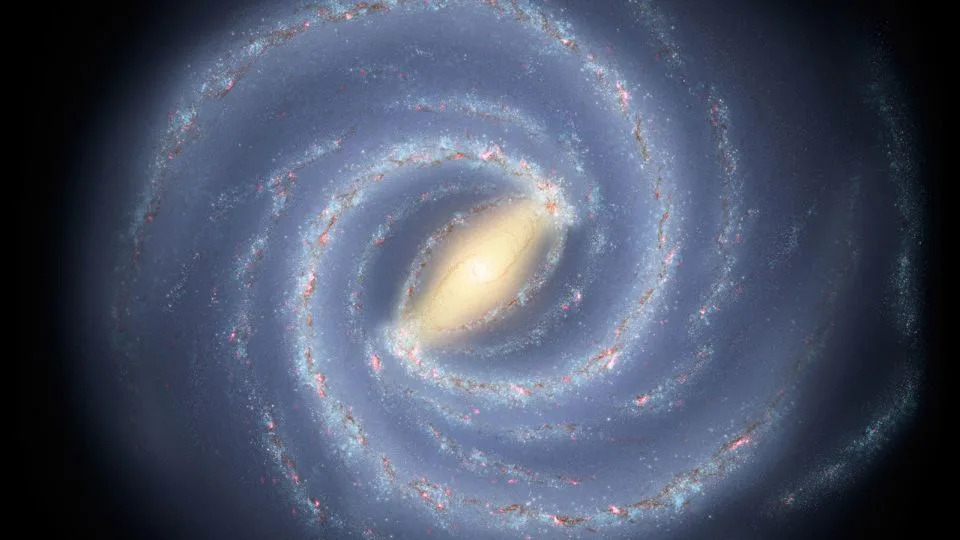
JPL-Caltech/NASA
Sign up for CNN’s Wonder Theory science newsletter. Explore the universe with news on fascinating discoveries, scientific advancements and more.
Astronomers have spied an intriguing phenomenon in the distant universe — a galaxy that closely resembles the Milky Way — and it’s challenging key theories on how galaxies evolve.
The faraway system, called ceers-2112, was spotted by an international team using the James Webb Space Telescope.
Like our home galaxy, the newly discovered ceers-2112 is a barred spiral galaxy, and it’s now the most distant of its kind ever observed. The bar at the center of the structure is made of stars.
Ceers-2112 formed soon after the big bang created the universe (which is estimated to be 13.8 billion years old), and the galaxy’s distinct structure was already in place 2.1 billion years later.
Given the distance between Earth and the objects from the early days of the universe, when telescopes like Webb observe light from the distant cosmos, it’s effectively like looking into the past.
“Unexpectedly, this discovery reveals that galaxies that resemble our own existed already 11,700 million years ago, when the Universe had just 15% of its life,” said lead study author Luca Costantin in a statement. He is a Spanish National Research Council postdoctoral researcher at Spain’s Centro de Astrobiología in Madrid.
Astronomers were surprised to see such a well-ordered and structured galaxy at a time when others were much more irregular. While massive spiral galaxies are common in the Milky Way’s cosmic neighborhood, that hasn’t always been the case.
The revelation, made possible by Webb’s highly sensitive light-detecting capabilities, is changing scientists’ understanding of galaxy formation and the beginning stages of the universe.
“Finding ceers-2112 shows that galaxies in the early universe could be as ordered as the Milky Way,” said study coauthor Alexander de la Vega, a postdoctoral researcher at the University of California, Riverside, in a statement. “This is surprising because galaxies were much more chaotic in the early universe and very few had similar structures to the Milky Way.”
A study detailing the findings was published November 8 in the journal Nature.
Early evolution of barred spiral galaxies
Astronomers thought barred spiral galaxies such as the Milky Way didn’t appear until the universe reached at least half of its current age because it was believed that it took several billion years of galactic evolution before the massive collections of stars within galaxies could form central bars.
The bars take shape when stars within spiral galaxies rotate in an orderly fashion, as they do in the Milky Way. Until now, astronomers didn’t believe early galaxies had enough stability for bars to form or last.
But the discovery of ceers-2112 has suggested that this evolution only took about 1 billion years or less, de la Vega said.
“Nearly all bars are found in spiral galaxies,” de la Vega said. “The bar in ceers-2112 suggests that galaxies matured and became ordered much faster than we previously thought, which means some aspects of our theories of galaxy formation and evolution need revision.”
Investigation of dark matter
De la Vega believes that astronomers will need to alter their theoretical models for how galaxies form and evolve by accounting for the amount of dark matter included in the earliest galaxies.
While dark matter has never actually been detected, it is believed to make up 85% of the total matter in the universe — and it’s something the European Space Agency’s Euclid telescope has been designed to map. Dark matter may have played a role in the formation of the bars.
The discovery also suggests that bars can be detected in early galaxies, despite the fact that the oldest galaxies are much smaller.
“The discovery of ceers-2112 paves the way for more bars to be discovered in the young universe,” de la Vega said. “Initially, I thought detecting and estimating properties of bars in galaxies like ceers-2112 would be fraught with measurement uncertainties. But the power of the James Webb Space Telescope and the expertise of our research team helped us place strong constraints on the size and shape of the bar.”
Webb Telescope Spots the Second-Most-Distant Galaxy Yet
Isaac Schultz
Tue, November 14, 2023
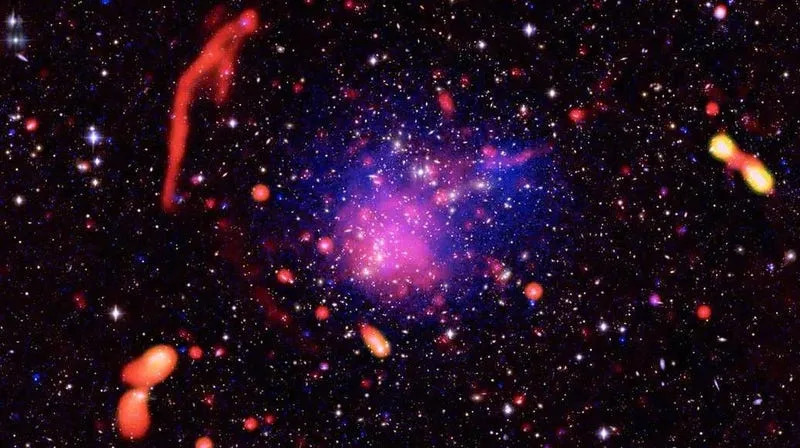
A composite image of Abell 2744 including Chandra, Subaru, and the Jansky Very Large Array data.
A recent deep field image from the Webb Space Telescope, showcasing a region of space known as Pandora’s Cluster, or Abell 2744, features two galaxies. These galaxies are remarkable for their distance from Earth, being the second and fourth most distant galaxies ever observed, according to a team of researchers that recently scrutinized the image.
Webb first observed Abell 2744 in June 2022, including some 60,000 other light sources in a deep field of the cluster. Now, spectroscopic data from the galaxies revealed their superlative distance: about 33 billion light-years away, according to astronomers. Research describing the newfound characteristics of the ancient galaxies was published this week in the Astrophysical Journal Letters.
The galaxies aren’t actually 33 billion years old. Their light was emitted when the universe was just 330 million years old (it is now nearly 14 billion years old), and it travelled about 13.4 billion light-years to reach Webb’s detectors. The universe’s expansion has stretched the distance between us and the galaxies, meaning they (or what remains of them) is now 33 billion light-years away.
“The light from these galaxies is ancient, about three times older than the Earth,” said Joel Leja, an astrophysicist at Penn State and a member of the UNCOVER team. “These early galaxies are like beacons, with light bursting through the very thin hydrogen gas that made up the early universe. It is only by their light that we can begin to understand the exotic physics that governed the galaxy near the cosmic dawn.”
The researchers believe that more distant galaxies should be visible to Webb’s piercing gaze, if they exist. It’s merely a question of seeing their extraordinarily faint light amidst the bedazzlement of stars in the cosmos.
More: Journey Into the Past: Webb’s Trippy 3D Animation Guides You to an Ancient Galaxy
Scientists used a galaxy cluster that warps space-time as a giant magnifying glass to find 2 distant galaxies
Grace Eliza Goodwin
Tue, November 14, 2023 at 10:55 AM MST·2 min read
13
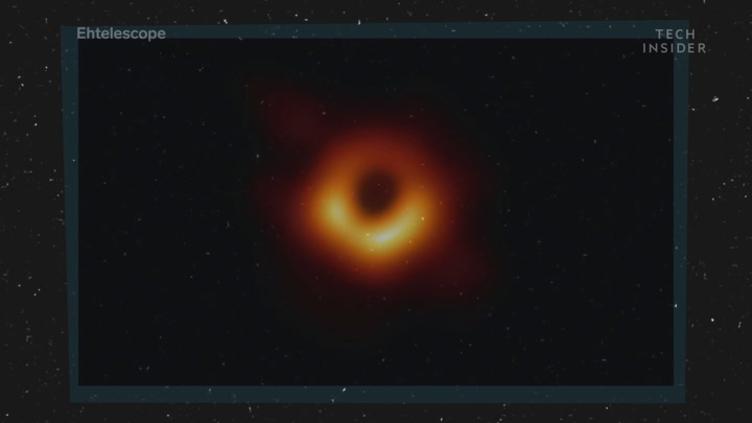
A team of astronomers used a cluster of galaxies like a magnifying glass to discover two never-before-seen distant galaxies.
Pandora's Cluster warps the fabric of space-time, creating a visual effect that magnifies light behind it.
The two newly uncovered galaxies are two of the most distant galaxies ever detected.
Scientists used a galaxy cluster that warps the fabric of space-time like a magnifying glass, helping them discover two of the most distant galaxies ever observed.
The team of astronomers at Penn State used NASA's James Webb Space Telescope to search for distant galaxies that were hiding behind Pandora's Cluster, or Abell 2744, a group of galaxies located 3.5 billion light-years away, according to Space.com.
The sheer mass of the galaxies within Pandora's Cluster creates a cosmic visual effect called a gravitational lens, which warps the fabric of space-time to magnify light that lies beyond, Penn State said in a press release about the team's findings.
Using this natural magnifying glass, the researchers were able to detect two never-before-seen galaxies behind the megacluster, 33 billion light-years away from Earth.
Only three other galaxies have ever been detected so far away, but these two galaxies are much larger, the research team said.
These two distant galaxies are also special because of their unique shape. Most far-away galaxies look like a dot in our images, but one of these is shaped like a "peanut" and the other like a "fluffy ball," the team said.
The scientists aren't quite sure how the galaxies became different shapes even though they formed from similar materials.
"The light from these galaxies is ancient, about three times older than the Earth," said Joel Leja, a member of the Penn State research team.
"These early galaxies are like beacons, with light bursting through the very thin hydrogen gas that made up the early universe," Leja added. "It is only by their light that we can begin to understand the exotic physics that governed the galaxy near the cosmic dawn."

No comments:
Post a Comment